Table of Contents
Last update on
SEO mistakes, whether technical, on-page, WordPress-related, or of any other nature, hurt your chances of competing in search engines. This has a negative effect on your website traffic and, in turn, causes other unpleasant outcomes, such as loss of revenue.
That’s a real pity because most SEO mistakes are easily avoidable. To help you do so, in this article, we will cover some of the most common ones in detail. You’ll learn how to spot it when you are making a particular SEO blunder and how to take corrective action.
Technical SEO Mistakes That Hurt Your Rankings
The technical infrastructure of a website forms the foundation for every other part of SEO. Therefore, screwing up here can spell trouble for your entire site.
1. Poor Crawlability
The main purpose of technical SEO is to make sure your site is crawlable and indexable. If it isn’t, you have no chance of appearing in search results.
Uzair Nazeer Bhat, Operations Director at Rank Math SEO, explains this concept well:
You can have the best content in the world, but if search engines can’t find it, it might as well not exist. Poor crawlability is often silent – but deadly for SEO. If your robots.txt, internal links, and sitemaps are not configured correctly, search engines will never see it.
Always audit your site structure as thoroughly as you’d for your best content. The sooner you fix crawl issues, the quicker your content can perform.
One of the easiest ways to know if you are making a mistake in this area is to type site:yoururl.com into Google. Doing so displays all content the search engine has indexed from your site.
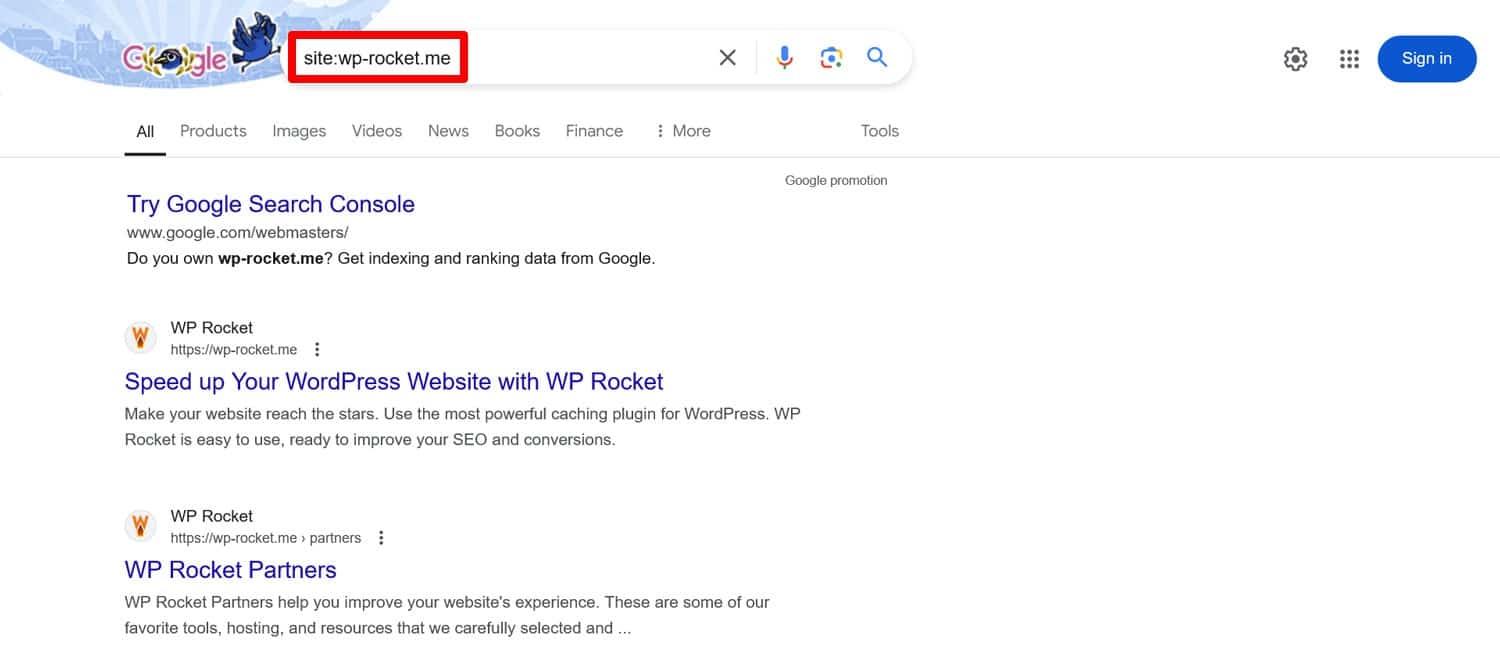
If nothing shows up, you have definitely found the reason you are not getting any traffic.
Another source of this information is the Pages report in Google Search Console.
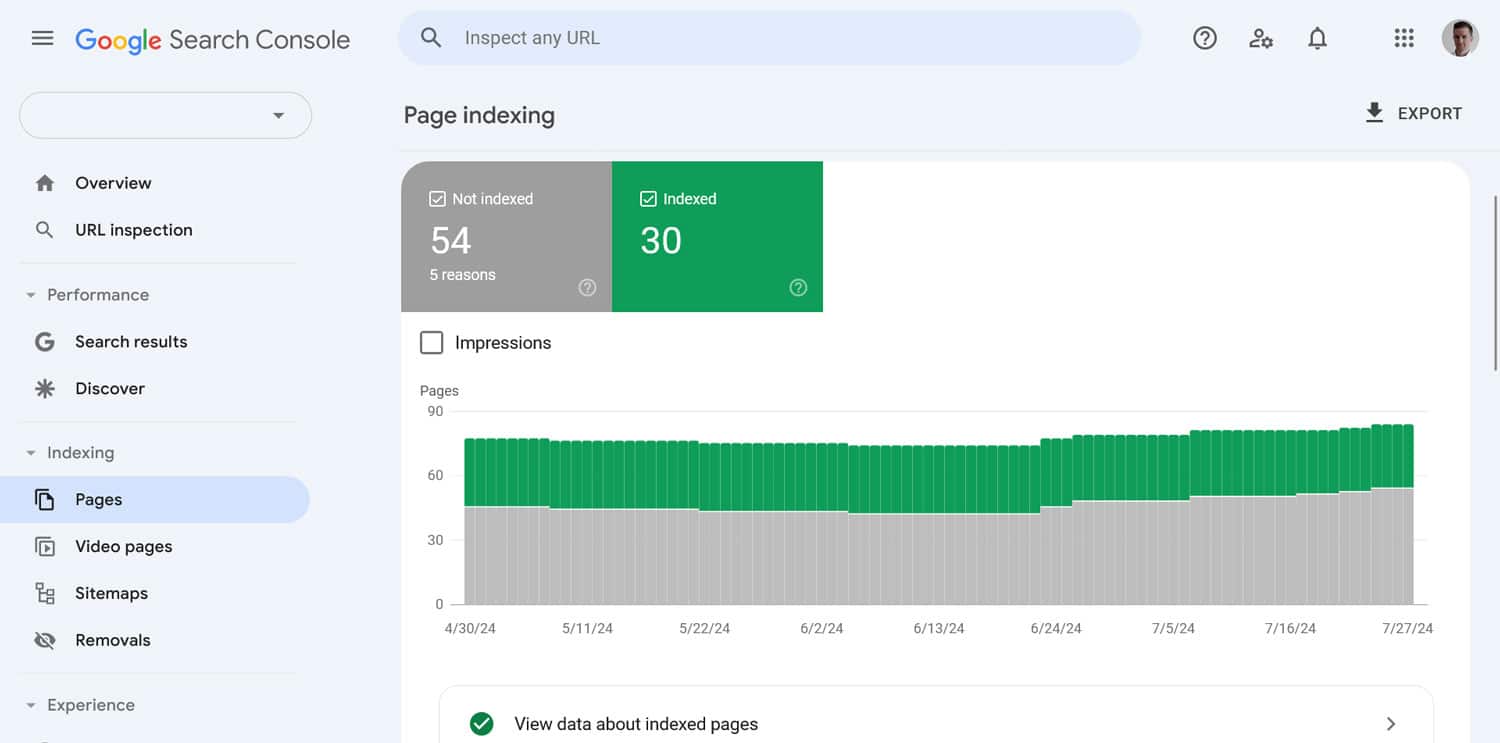
It, too, will tell you about pages Google hasn’t indexed and why.
How to Fix Crawl Problems
A good way to fix crawlability issues is to use the information in Google Search Console for why certain pages haven’t been indexed.
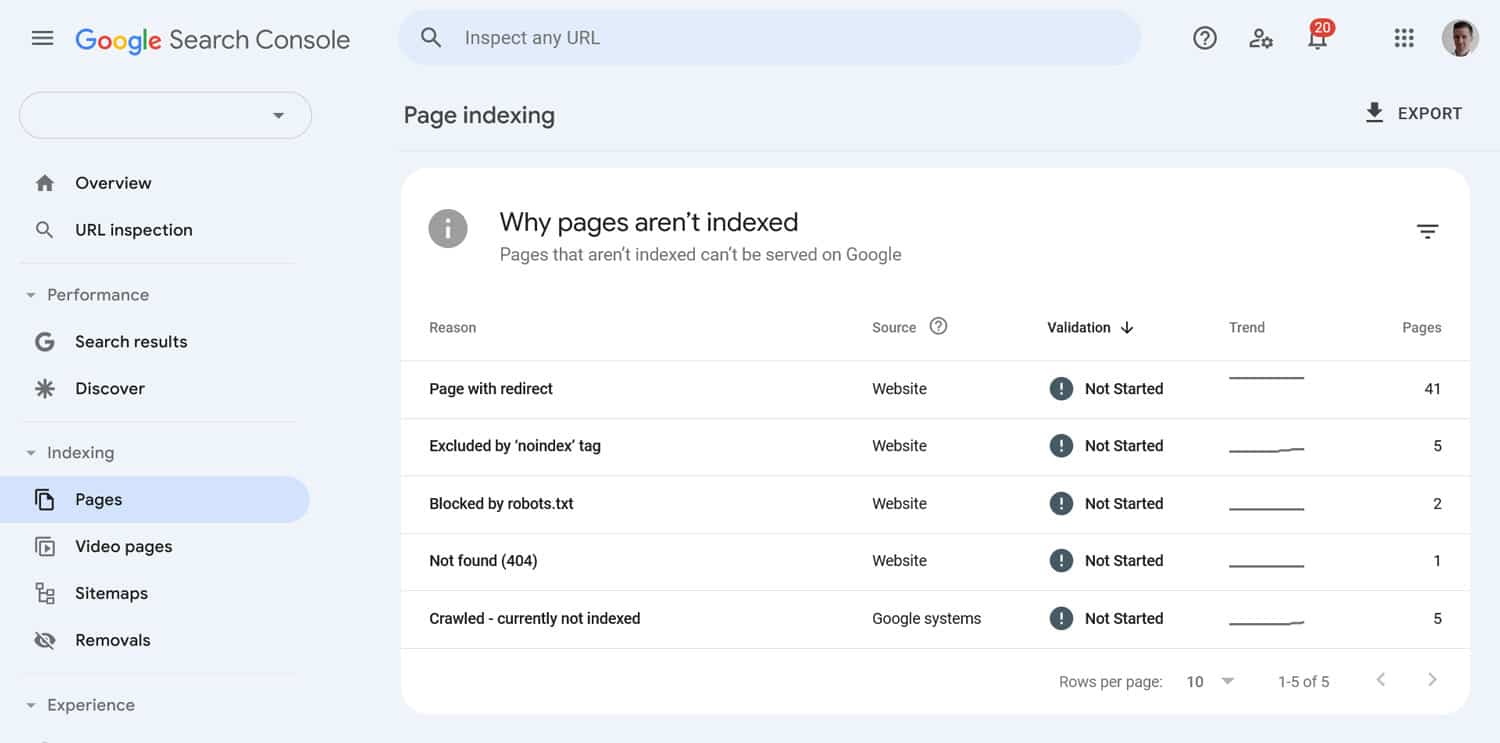
An important place to check here is robots.txt, a powerful server file that contains directives telling search engine crawlers which content they may access and which not. It is possible to configure it in a way that it completely forbids search engines to index your site. Learn more about robots.txt here.
Another important step is to create and submit a sitemap to Google Search Console.
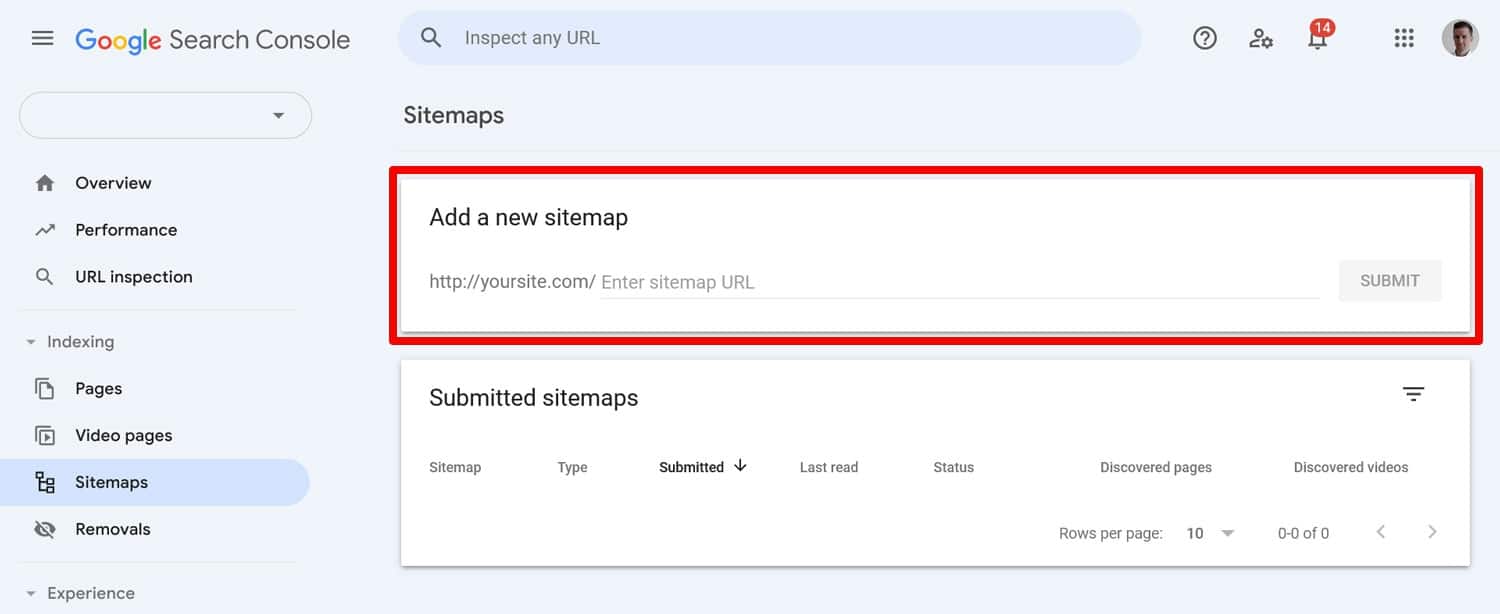
A sitemap is a list of all the content on your site. It helps search engines know what’s available so they can crawl and index it.
You can also use Search Console to tell Google to index pages manually. Just input the address at the top, have it analyzed, and then request indexing.
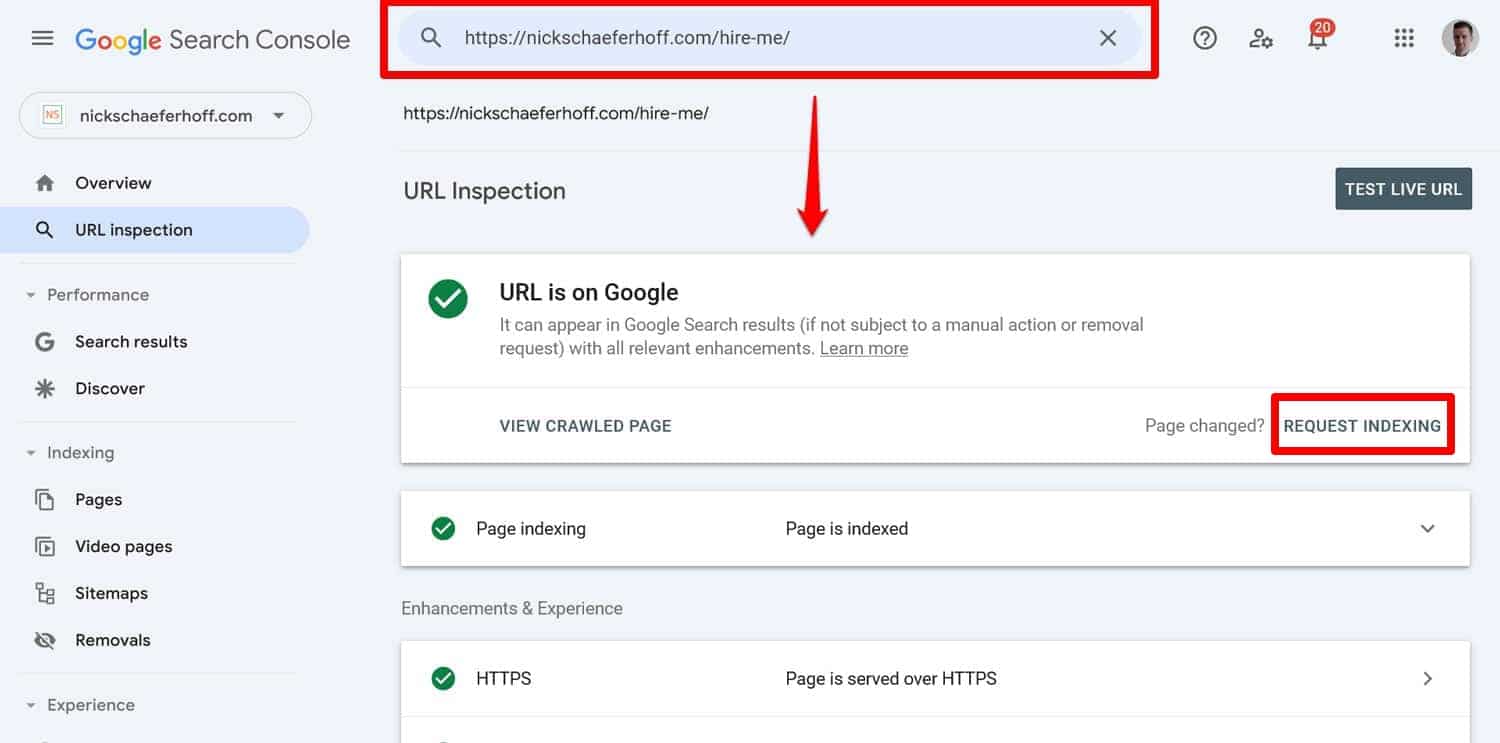
Another factor can be internal links, so pay attention to the internal linking mistakes below.
2. Not Using SSL/HTTPS
HTTPS/SSL encrypts data transmitted between visitors and your website. Search engines favor websites that use it, and it’s absolutely mandatory if you process online payments. Therefore, not using it is an obvious SEO mistake.
To spot if you are guilty of it, check whether your browser bar displays a padlock symbol when on your own website.

Issues in this area also show up in Google Search Console under Experience > HTTPS.
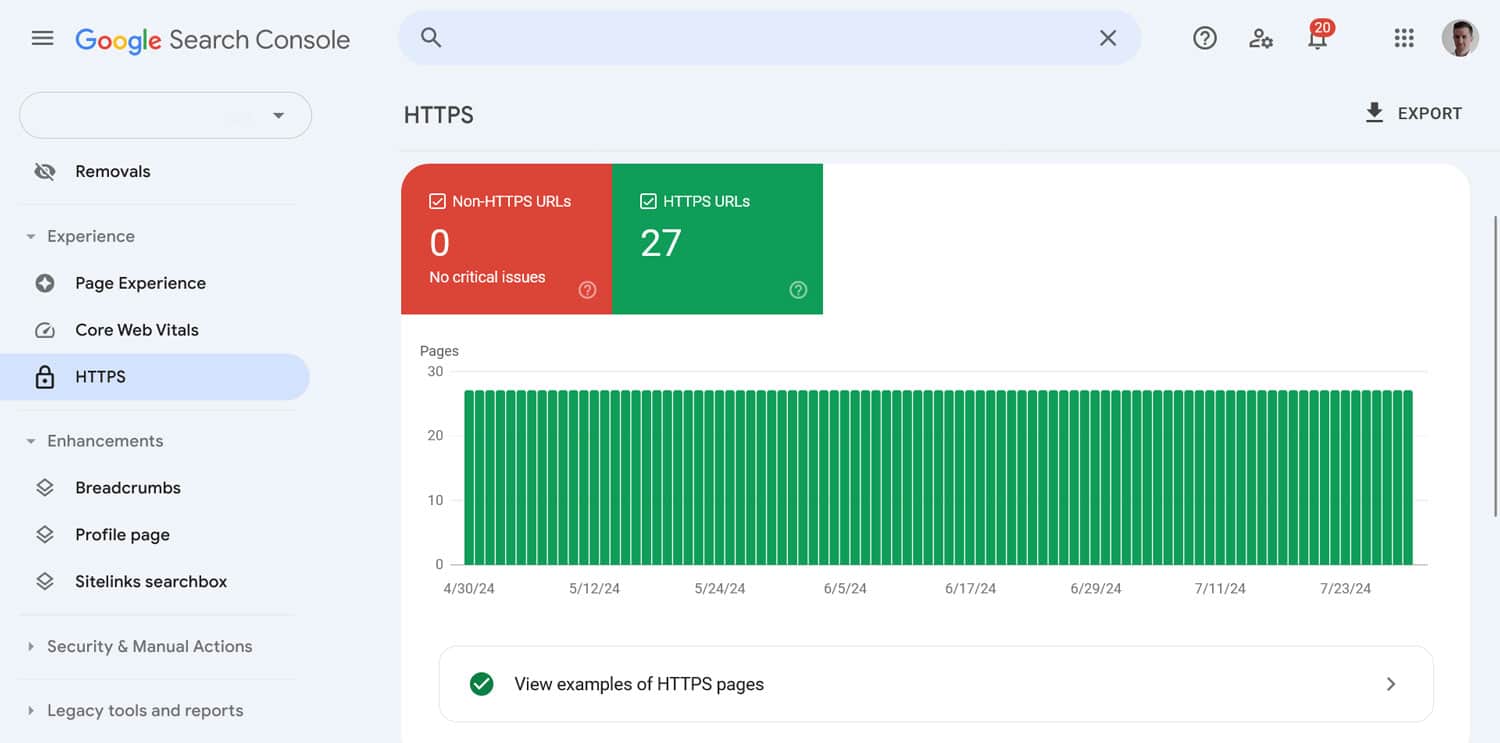
How to Fix Missing Encryption
The fix for this SEO blunder is clear: obtain and install an SSL certificate. Thankfully, that’s usually not hard; most hosting providers allow you to do it in your hosting back end with a few clicks.
If your WordPress site was running without HTTPS so far, a plugin like Really Simple SSL makes the switch easier.
3. Slow Site Speed
People may find it surprising to hear that website speed is an SEO issue. But search engines, especially Google, have made it very clear that performance is a central ranking issue because of its importance for user experience. Google specifically introduced its Core Web Vitals metrics to measure and improve this area.
If you want to know if you are committing the SEO sin of having a slow site, your first step is to speed test your website. Tools like PageSpeed Insights give you a detailed problem analysis and solutions.
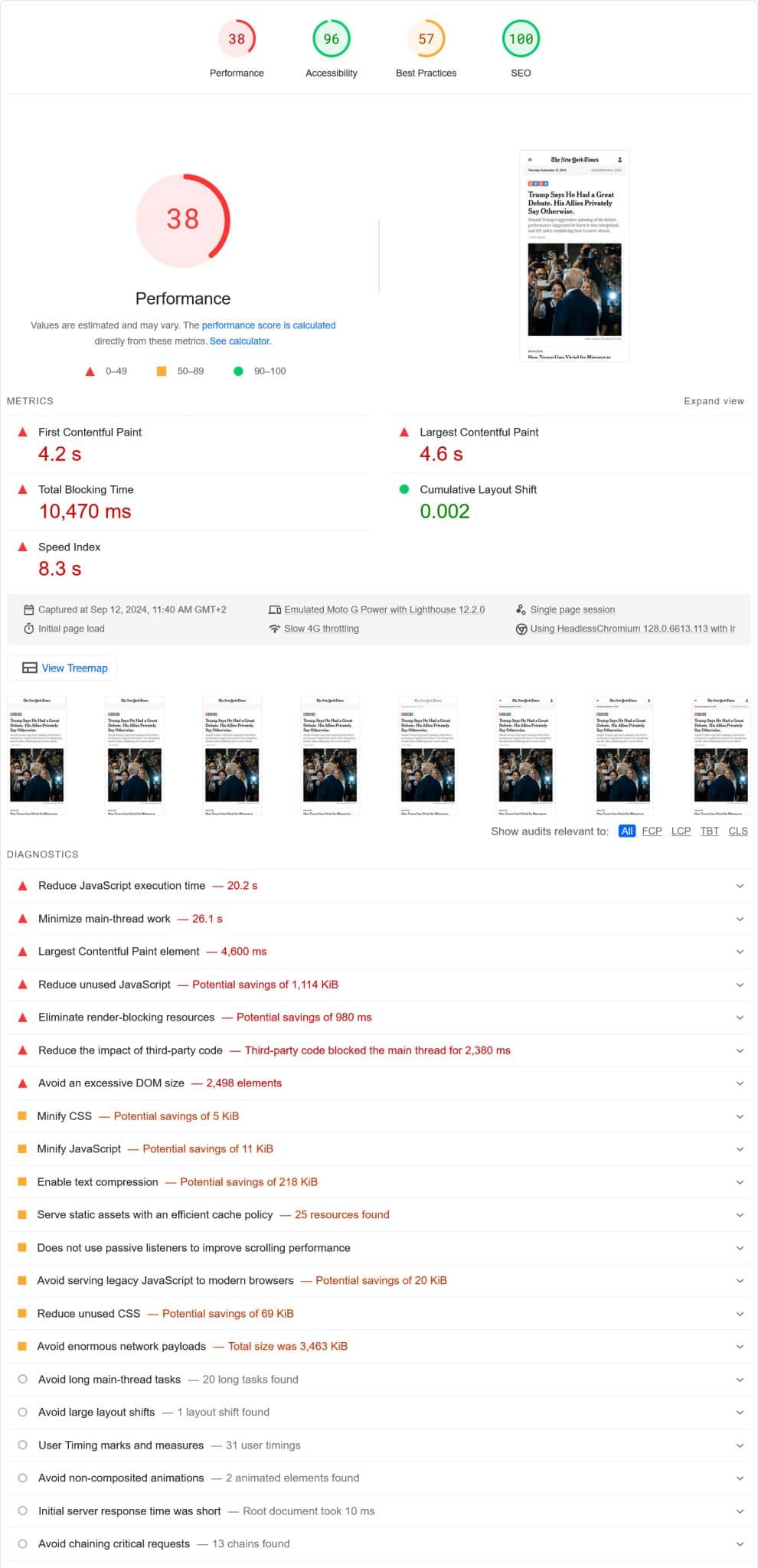
How to Fix Page Speed Problems
If you discover that you are erring in this area, the good news is that there are many ways to address performance issues. Examples include caching, code optimization like reducing and minifying website files, or using a Content Delivery Network (CDN).
If you feel out of your depth doing this by hand, you can alternatively use a performance plugin like WP Rocket. It contains all the necessary features to speed up a website, including:
- Caching, including for mobile devices
- Lazy loading for images and videos
- Minifying and deferring render-blocking resources
- Preloading cache, links, external files, and fonts
- Database optimization
Even better, it implements many optimization steps automatically, like browser and server caching, GZIP compression, improving images above the fold (since those are usually the LCP element), and several smaller improvements. This means your site will get faster just by switching the plugin on.
In addition, WP Rocket has a super easy interface, allowing you to make sweeping changes with just a few mouse clicks.
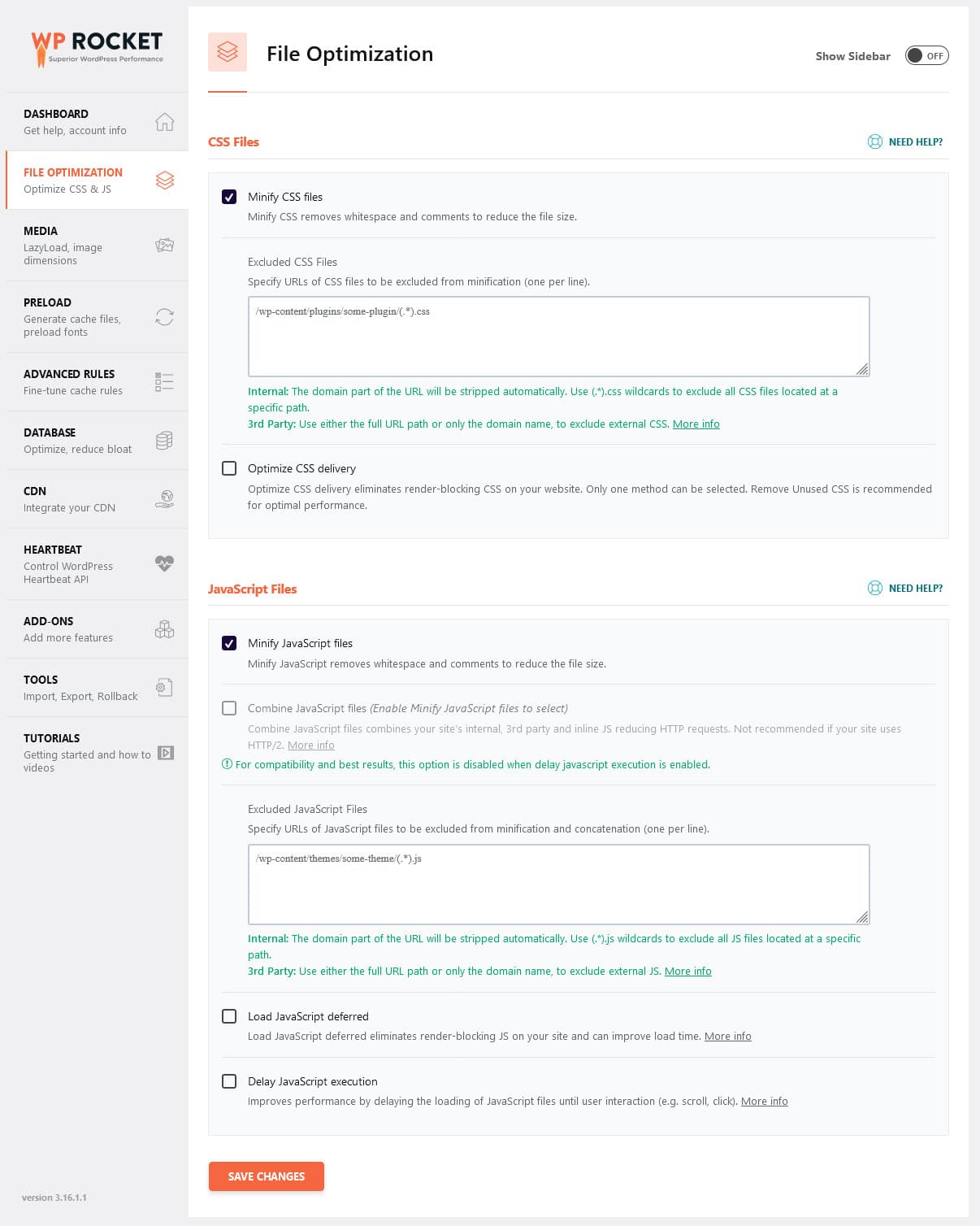
Finally, it comes with a 14-day money-back guarantee, so you can test it without any risk.
For the best results, be sure to also pay attention to the image optimization tips below!
4. Duplicate Content
Duplicate content is another SEO mistake that is as common as it is avoidable. It means two pages have exactly or largely the same content.
This can happen, for example, if you have pages with the same language but for different locales, like Argentinian and Mexican Spanish, and don’t implement hreflang tags properly.
Duplicate content can also occur when your site is available under multiple addresses, such as:
- https://www.yoursite.com
- https://yoursite.com
- http://www.yoursite.com
- http://yoursite.com
Content duplication is problematic because it confuses search engines and can make your site appear as low-quality. As a consequence, they might index the wrong page, index no page at all, or or you might experience unstable ranking positions.
How to Fix Duplicate Content Issues
The first step to fixing duplicate content is to find it. You can do that with a tool like Screaming Frog or Semrush. Once identified, use these methods to get rid of duplicate content:
- Settle on a single site address and point all internal links to it
- Add unique content to one of your duplicate pages
- Include canonical tags or hreflang tags to point search engines to the page you want to rank
- Set up redirects if necessary
Beware of These (Basic) WordPress SEO Pitfalls!
In this next part, let’s talk about errors in search engine optimization that typically happen on WordPress websites and how to fix them.
5. Blocking Search Engines in Settings
Something you should immediately check if there is an indexing issue with your site is Settings > Reading in the WordPress dashboard. It contains an option to discourage search engines from indexing your site. It’s often activated during development and then forgotten.
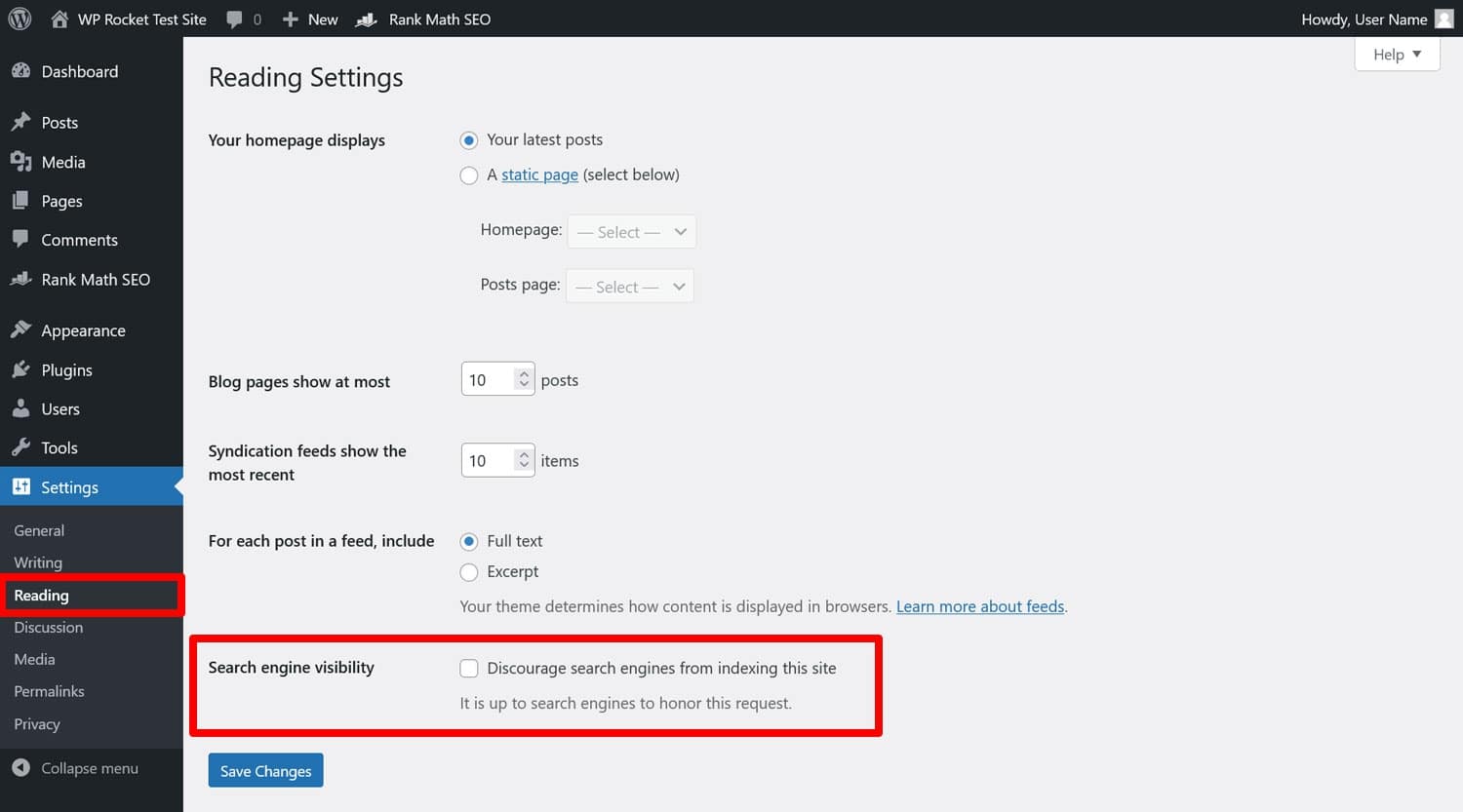
How to Fix WordPress Indexing Problems
Thankfully, if you discover this particular blunder, the solution is very easy. Simply uncheck the box and save it at the bottom.
However, there are other ways to block indexing inside WordPress. Pretty much all SEO plugins have options to set individual pages or page types to noindex. So if you use such a plugin and some of your content refuses to show up in search, make sure this isn’t the cause.
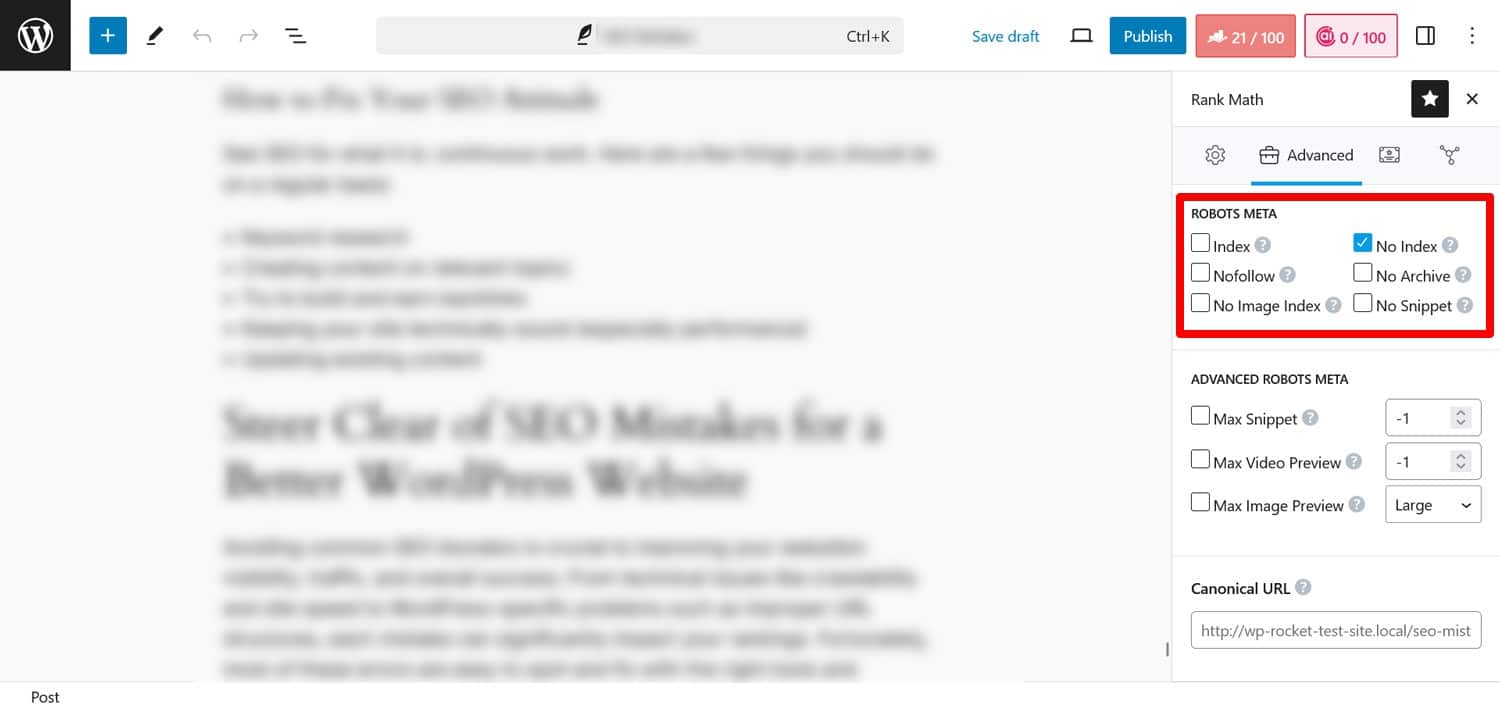
6. Using the Wrong URL Structure
Your site’s URL structure helps visitors and search engines understand the content and website hierarchy—if you set it up right. A sign that you didn’t is when your page addresses look like this:
- https://www.yoursite.com/p=883
- https://www.yoursite.com/archives/883
Neither of these URLs say a lot about the content of the pages they lead to. And that’s the problem.
How to Fix Your WordPress URL Structure
WordPress lets you control URLs in two different places: Settings > Permalinks and the page and post editor.
The first option allows you to set the overall URL structure.
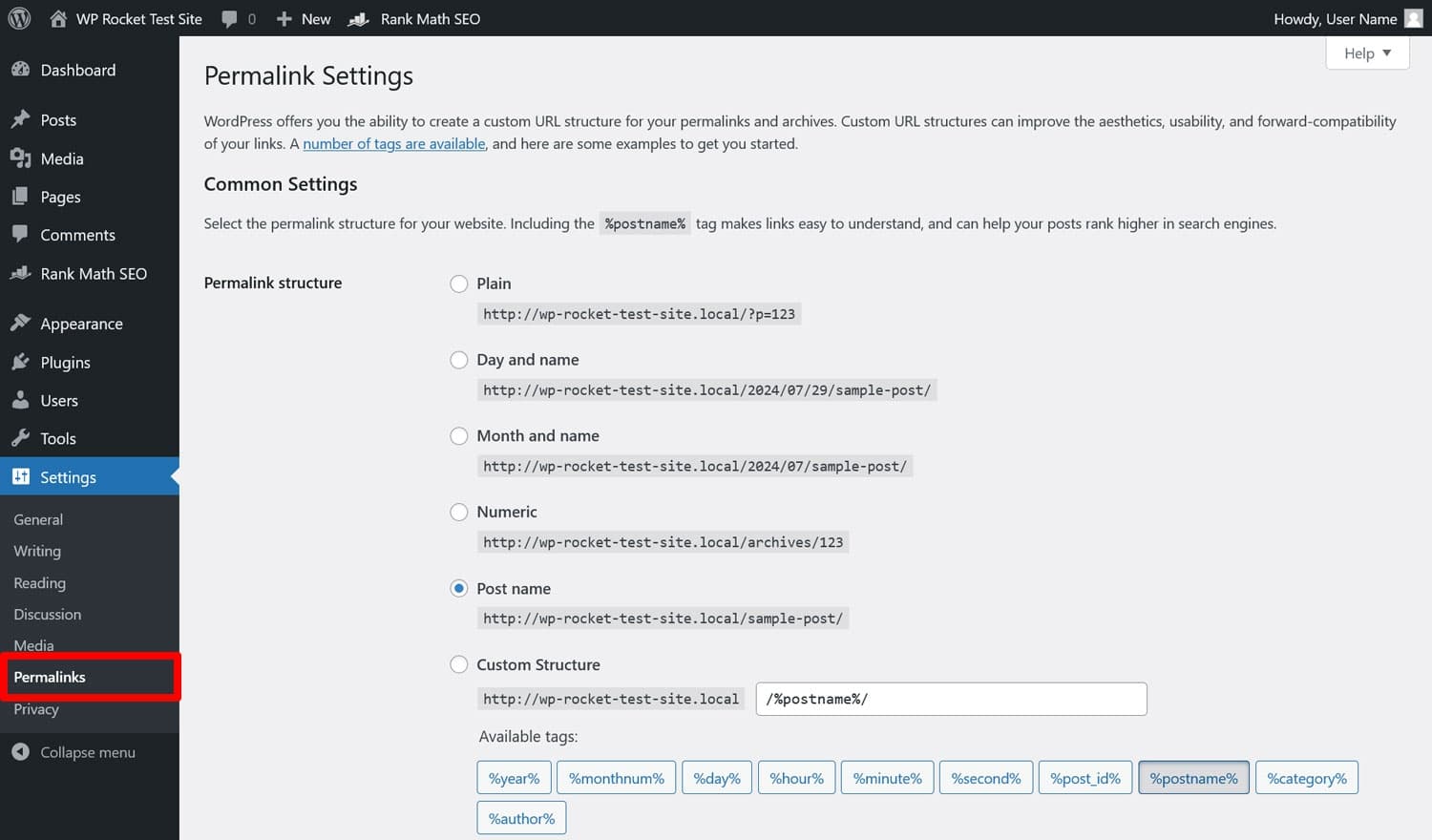
Choosing Post name is the most common option. You can also include categories in your URLs, however, avoid dates unless it makes sense, for example, for a news site.
Then, create meaningful slugs, which is the end part of the URL, in the WordPress editor sidebar.
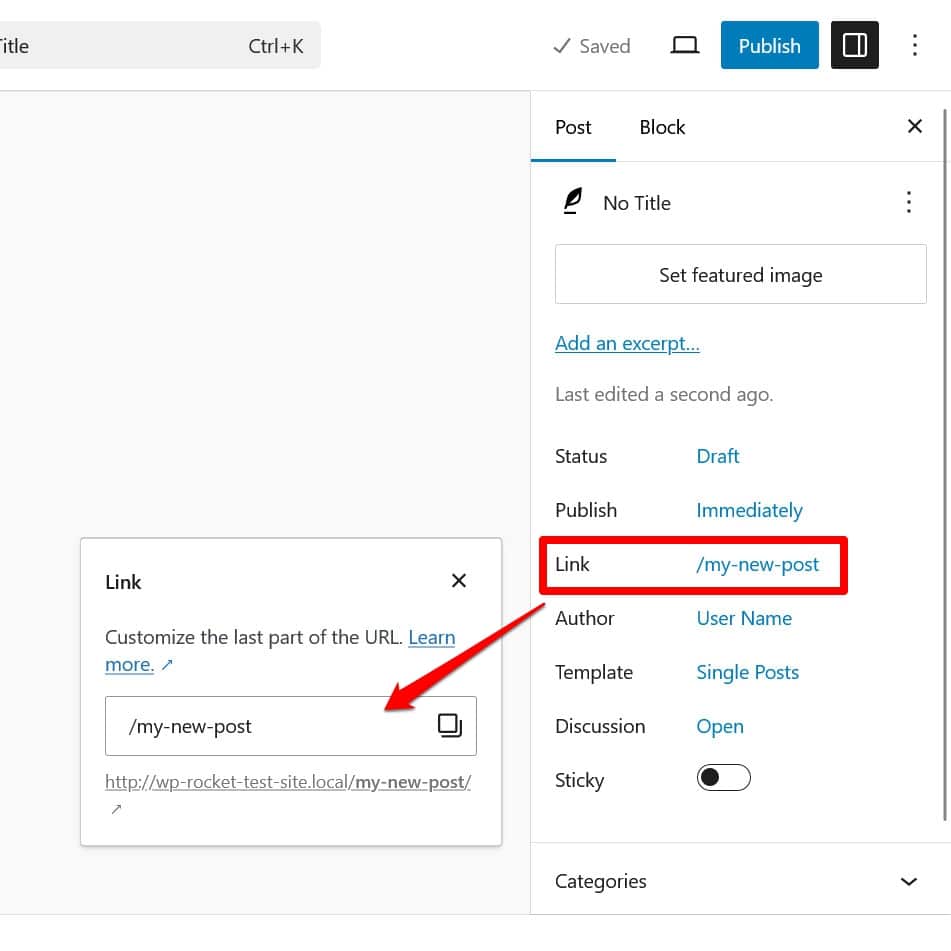
Keep them short and descriptive, and include the main keyword. That’s pretty much it.
7. Not Using Categories and Tags Correctly
WordPress taxonomies like categories and tags not only bring order to your content, they also affect your search engine optimization. That’s not least because WordPress automatically creates archive pages for them that can appear in search results. These are also a frequent source of duplicate content, e.g., if a category has the same content as your blog page.
Plus, as mentioned, taxonomies can also be part of your URLs, so using them incorrectly can really mess with your SEO.
How to Fix WordPress Taxonomy Usage
First, know which taxonomy to use for what. Categories are for broad groupings of content, like your blog’s main topics and subtopics. Tags, on the other hand, add information specific to each content piece, like the index of a book. They are also optional, while categories are mandatory.
To make the most of them, limit your categories to between eight and ten. If you need more than that, consider setting up subcategories instead. Then, when you create content, assign one to three categories to each blog post.
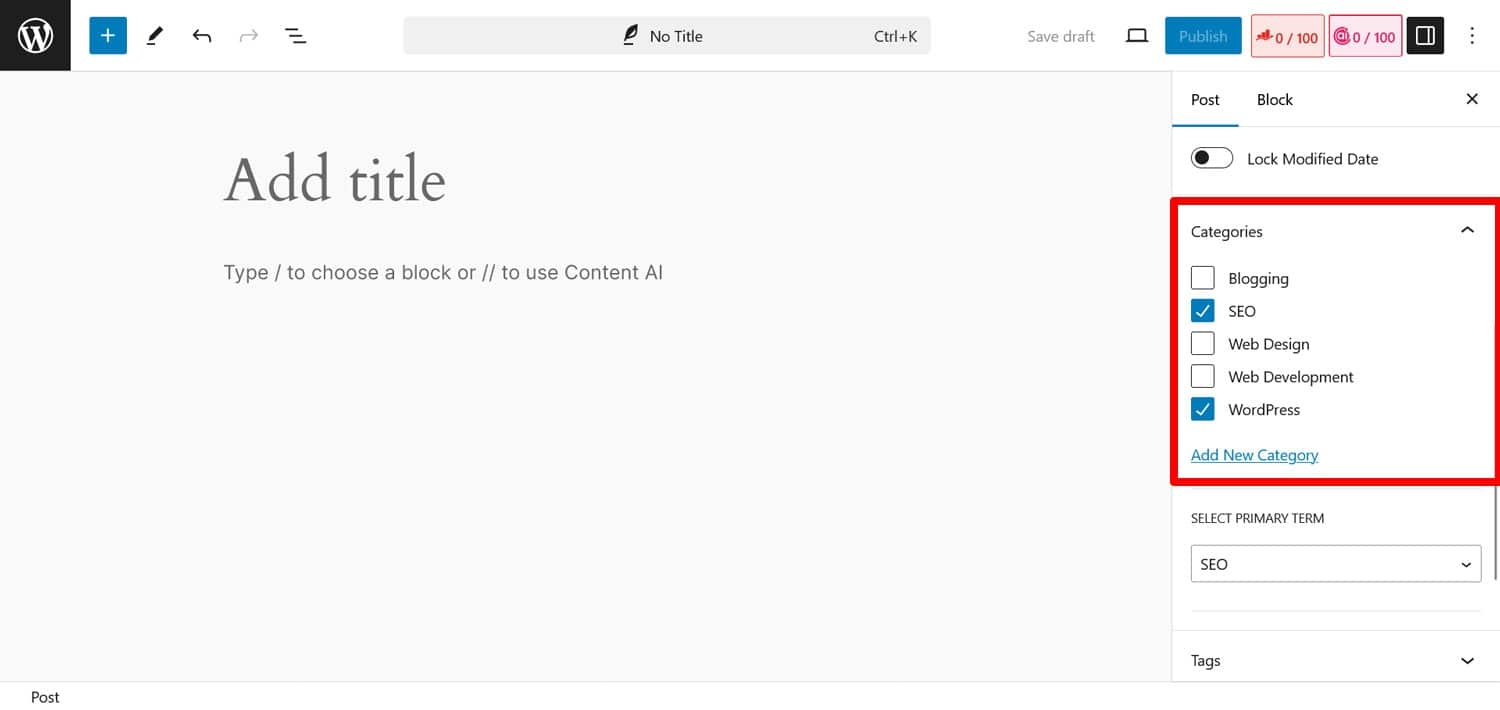
What’s more, add unique content to archive pages to avoid duplicate content issues. You can do that by filling in descriptions and titles while editing specific WordPress categories.
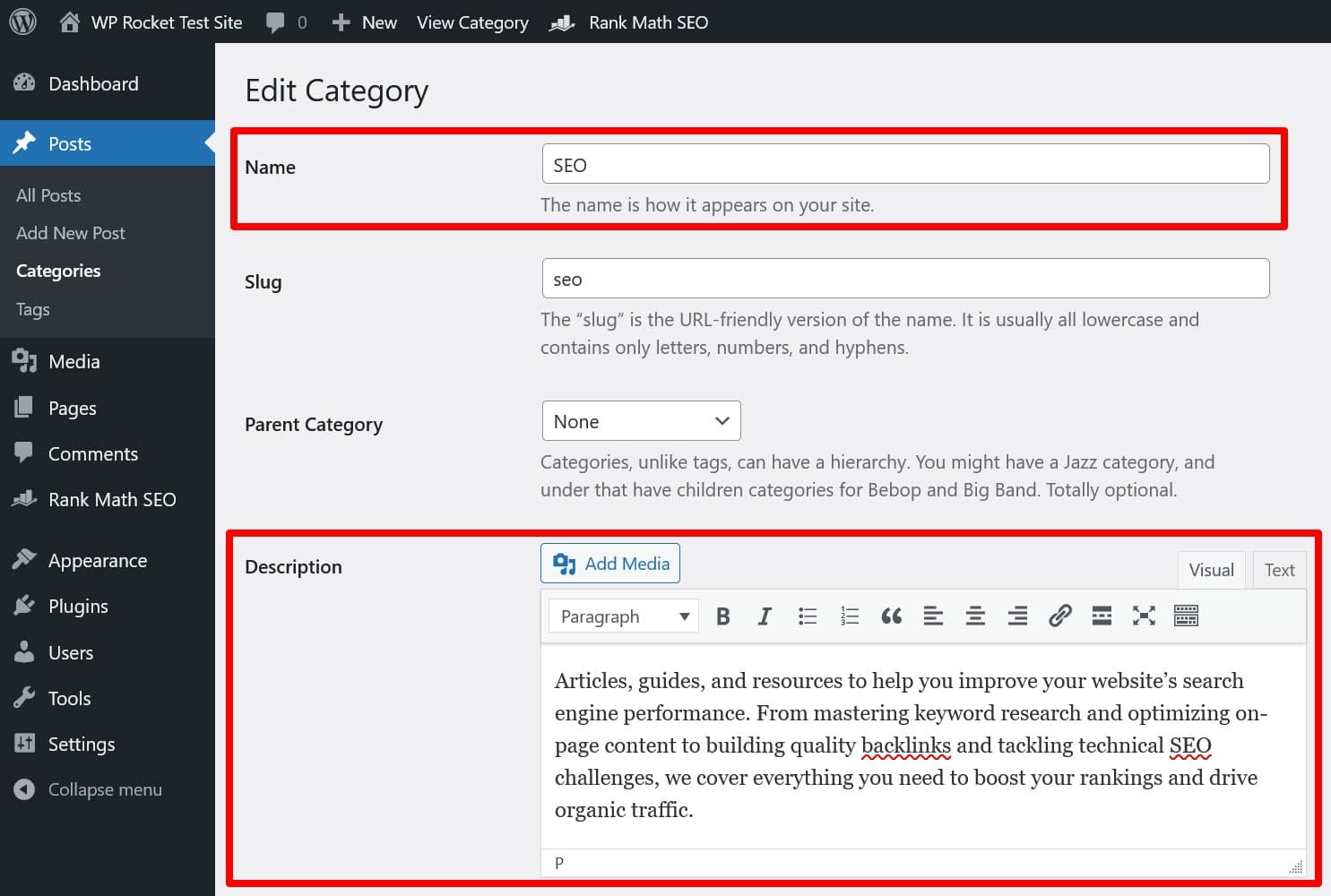
Whether this information shows up on your site depends on your theme. SEO plugins and some themes also have extra functionality to implement this, as well as the ability to customize SEO titles and meta descriptions.
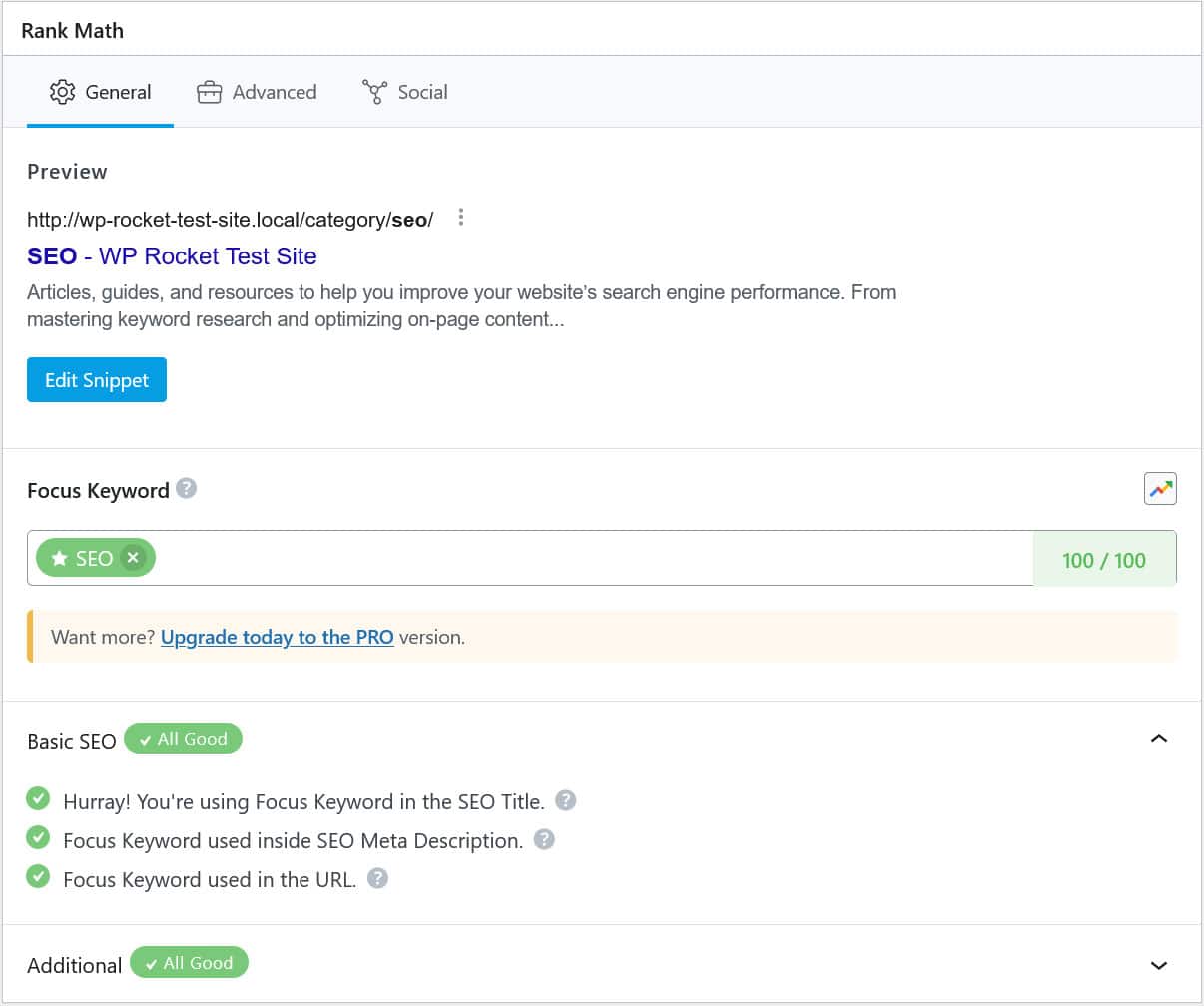
Finally, use an SEO plugin to control which archive pages search engines should index and which ones not. Some of them are not that important, e.g., the date archives and most plugins have good default settings for this.
8. Not Using a WordPress SEO Plugin
Speaking of which, not taking advantage of the SEO plugins WordPress offers is another serious mistake. They come with a lot of functionality to help optimize your website for search results.
For example, SEO plugins help tremendously with on-page SEO. Many include content analysis modules to let you know how well-optimized your content is for your keyword(s).
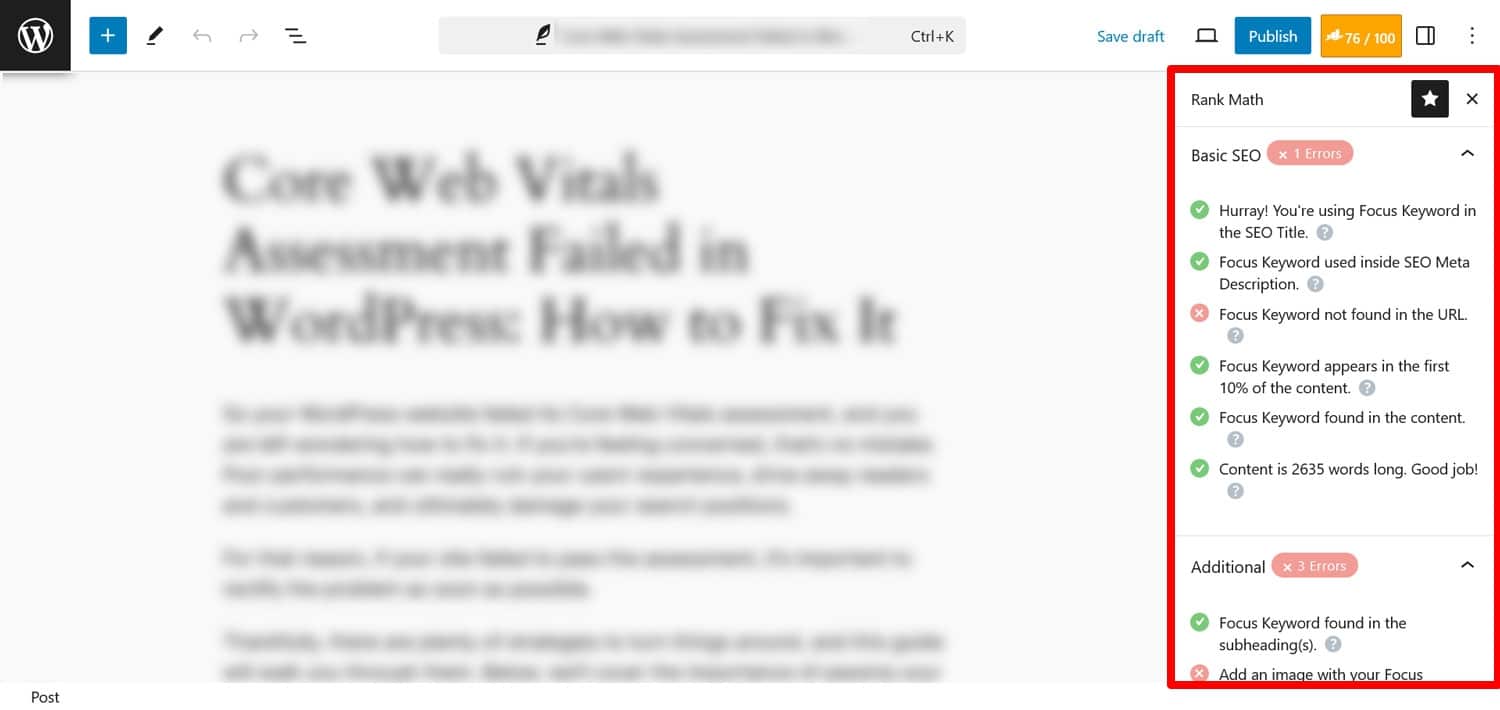
Most importantly, they allow you to preview and customize SEO meta information like the title and meta description.
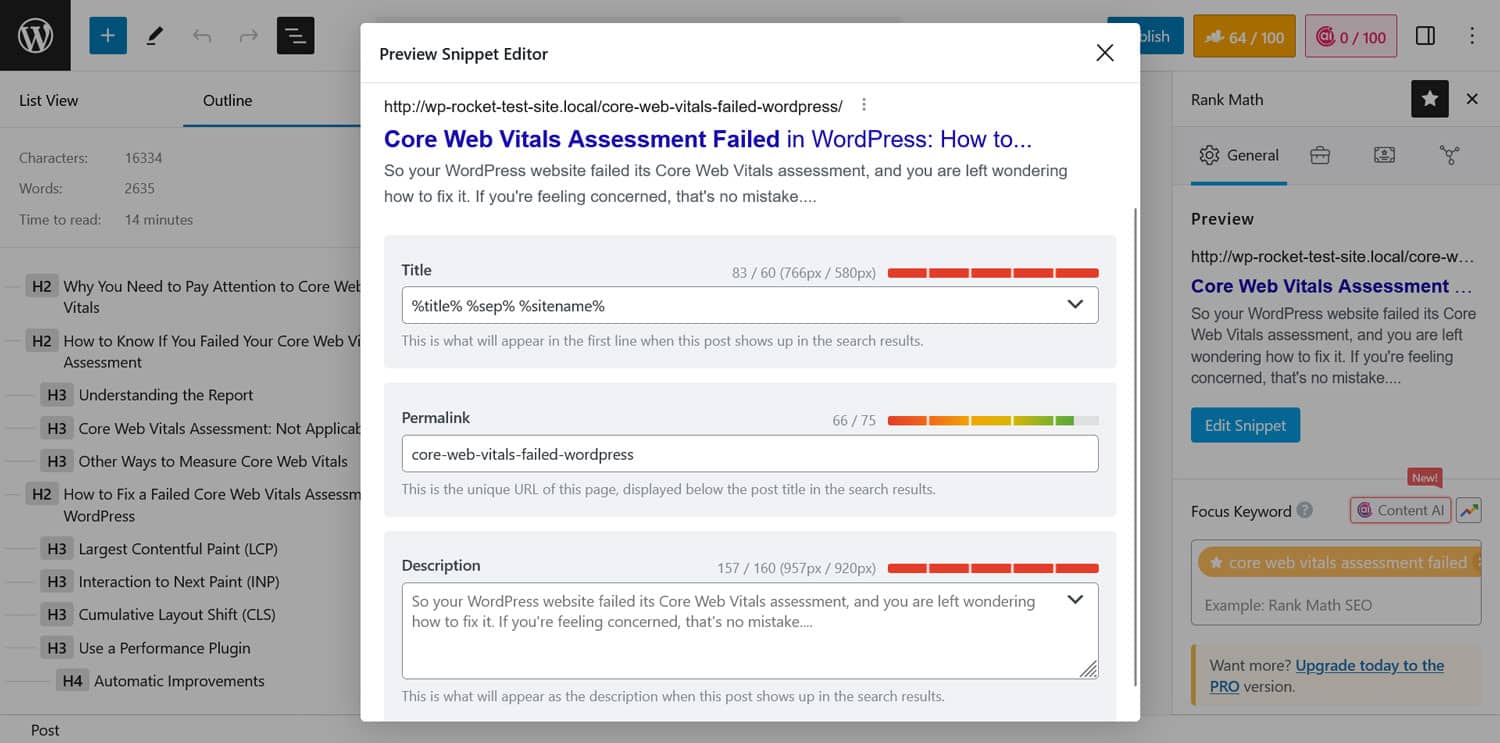
These show up in search results and have a huge impact on whether someone clicks on your article or not.

How to Fix a Lack of SEO Plugins
The solution to this SEO problem is quite obvious, isn’t it? Install an SEO plugin!
Do you want a specific recommendation? Rank Math is a great option with all the functionality you need to make your content stand out online.
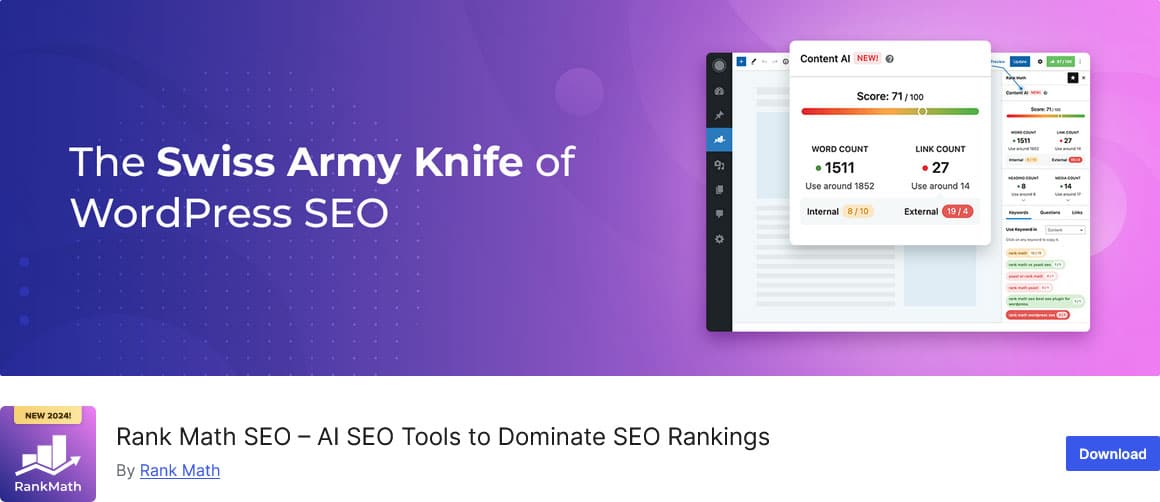
Keyword Research Mistakes That Have No Place in Your Life
Keyword research is one of the main building blocks of SEO. Consequently, making mistakes in this area could cost you dearly.
9. Poor Keyword Research
The first thing you can screw up is the keyword research itself. Common mistakes include:
- Not doing research at all – If you don’t look into what topics your audience is interested in and the phrases they use to search for them, you’ll have a hard time appearing for relevant search queries.
- Picking the wrong keywords – All keywords are not created equal. Choosing unsuitable key phrases is pretty much as bad as selecting none at all. A common mistake here is going for keywords with too much competition, where you have no meaningful chance of ranking, or phrases that are too generic.
- Targeting only a single phrase – The time for single-keyword content is over. If you don’t take into account related key phrases, you’ll likely write thin content or keyword-stuff your page.
Speaking of mistakes, Uzair Nazeer Bhat, Operations Director at Rank Math SEO, points out:
Chasing the wrong keywords can waste all your SEO efforts—and money.
You might rank #1, but if no one who visits actually needs what you offer, it won’t help your business. Good keyword research is about finding the real questions your audience/customers are asking. Focus on those specific, often long-tail phrases that bring visitors who actually want to buy, sign up, or take action.
How to Fix Suboptimal Keyword Research
One of the main ways to improve your research is to look for more specific keywords consisting of several words, so-called long-tail keywords. These are easier to rank for and allow you to attract more targeted visitors.
Since keyword research is a complex topic we can’t cover completely here, check out this article for a good primer.
10. Disregarding Search Intent
We already touched on this in the previous section. We are now living in a post-keyword world. It’s no longer enough to pick a single key phrase and optimize the hell out of it. These days, Google cares much more about fulfilling the intent behind search queries—why someone searched for a specific phrase. Ignoring that fact would be a mistake.
How to Fix Missing Search Intent
The solution is two-fold. First, you need to understand the search intent of your web pages, then ensure you fulfill them. Different kinds of search intent are:
- Informational — The searcher simply wants to know more about a topic, e.g. “gardening”.
- Commercial/transactional – In this case, they have a particular product or service in mind and are considering their options. A typical keyword here would be “best gardening gloves”.
- Navigational — These queries aim to find a specific company and its website, such as “Acme gardening equipment”.
Once you understand what particular intent each of your pages aims to fulfill, make sure it does! That means, for example, optimizing a page with commercial intent for conversions or ensuring an informational page delivers the best possible advice.
11. Keyword Cannibalization
A final SEO mistake in keyword research is competing with yourself. Keyword cannibalization is when you create separate content pieces on topics so closely related they have considerable overlap regarding keywords.

This can seriously hurt your rankings because it can confuse search engines about which content piece to rank for specific keywords. As a consequence, you might not end up ranking at all.
How to Fix Keyword Cannibalization
Again, it comes down to keyword research and intent. Create content that’s clearly focused on different parts of your overall site topic and has a distinct purpose. For duplicate content issues, follow the practices outlined above.
Common Mobile SEO Screwups That Will Hurt Your Site
More people access the Internet with mobile devices than with desktop computers.
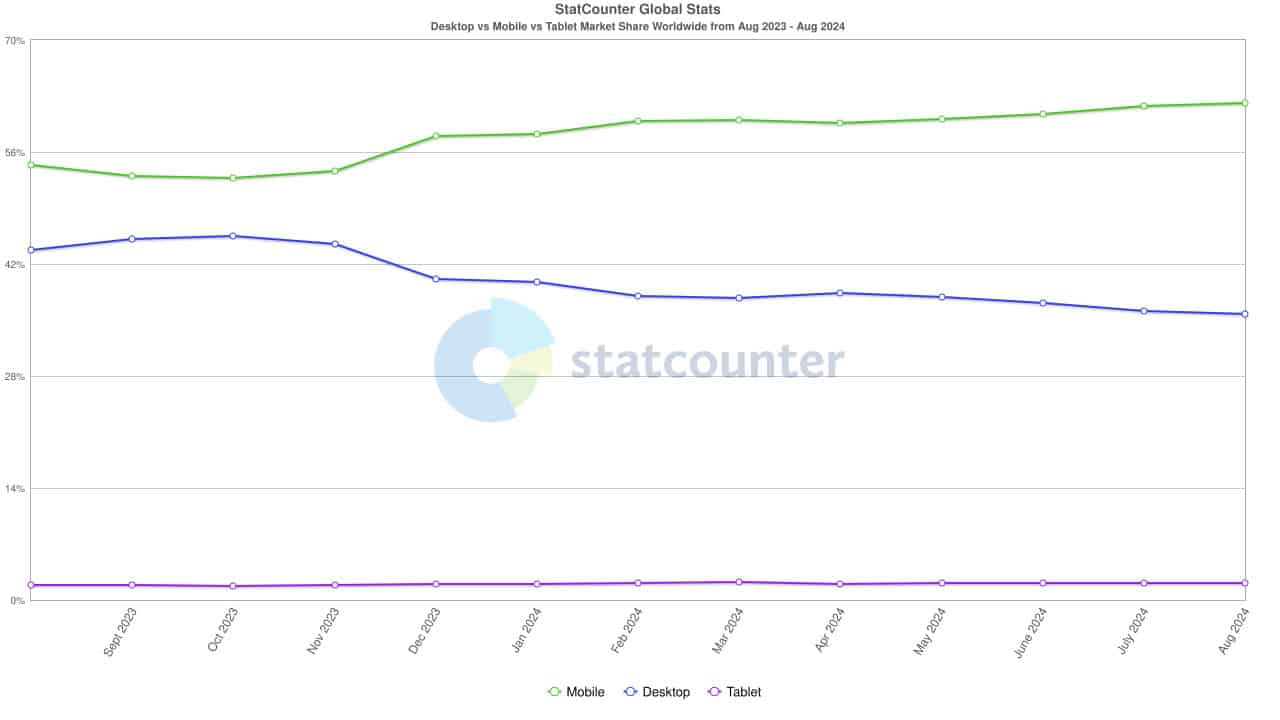
As a consequence, Google switched to a mobile-first index in 2018. That means it looks at the mobile version of your website to determine where it should rank. Reason enough to ensure you are not committing any serious mobile SEO blunders, don’t you agree?
12. Not Testing and Optimizing Your Mobile Performance Separately
You can see Google’s focus on the mobile version of your site in the fact that PageSpeed Insights displays performance results for mobile separately as well as first.
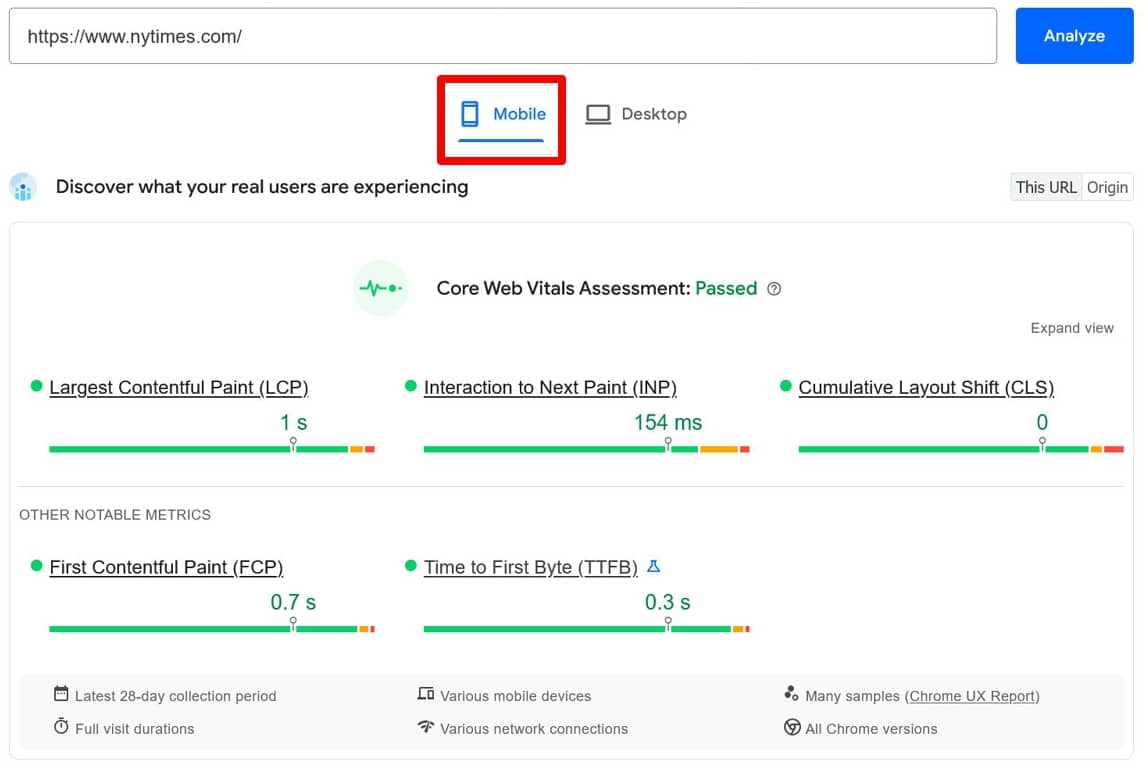
Here, it’s also obvious that one of the things Google most cares about are Core Web Vitals metrics, which measure user experience. If you want to learn more about those, check our articles on Largest Contentful Paint, Interaction To Next Paint, and Cumulative Layout Shift.
How to Fix Mobile Page Performance
The way to approach this SEO mistake is to simply pay attention to your mobile performance test results. They will tell you very clearly what the problems are and also how to fix them.
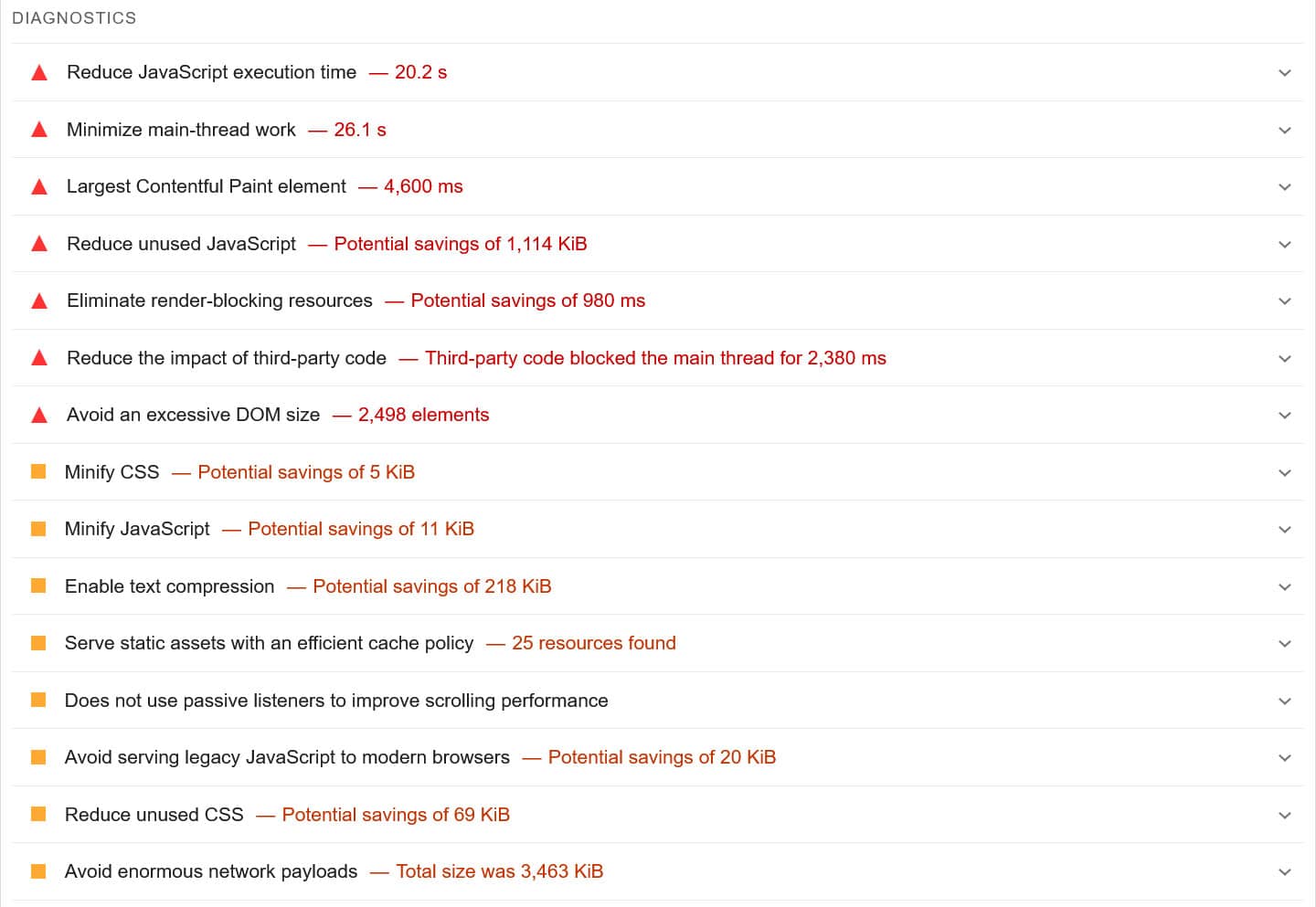
What especially helps is using a performance plugin that comes with mobile caching (as WP Rocket does, by default). Then, follow the general performance advice mentioned above.
13. Lack of Mobile Friendliness
Besides performance, the other big mobile issue is usability. Surfing on mobile devices is different due to smaller screen sizes as well as interaction via touch. Google tracks usability signals as part of its algorithms, so bad performance in this area is an SEO mistake to avoid.
How to Fix Missing Mobile Friendliness
An important factor here is your theme. It controls both your site’s design and its underlying code, including how it displays on mobile devices. We have a number of helpful articles on this topic:
- How to Choose the Best WordPress Theme For Your Website
- The 10 Fastest WordPress Themes
- The 8 Fastest WooCommerce Themes
- 10 Best and Fastest WordPress Themes for Blogs
To find any other issues, run your site through a mobile-friendliness test. It will tell you if your text is large enough to read, button sizes sufficient to tap, and more.
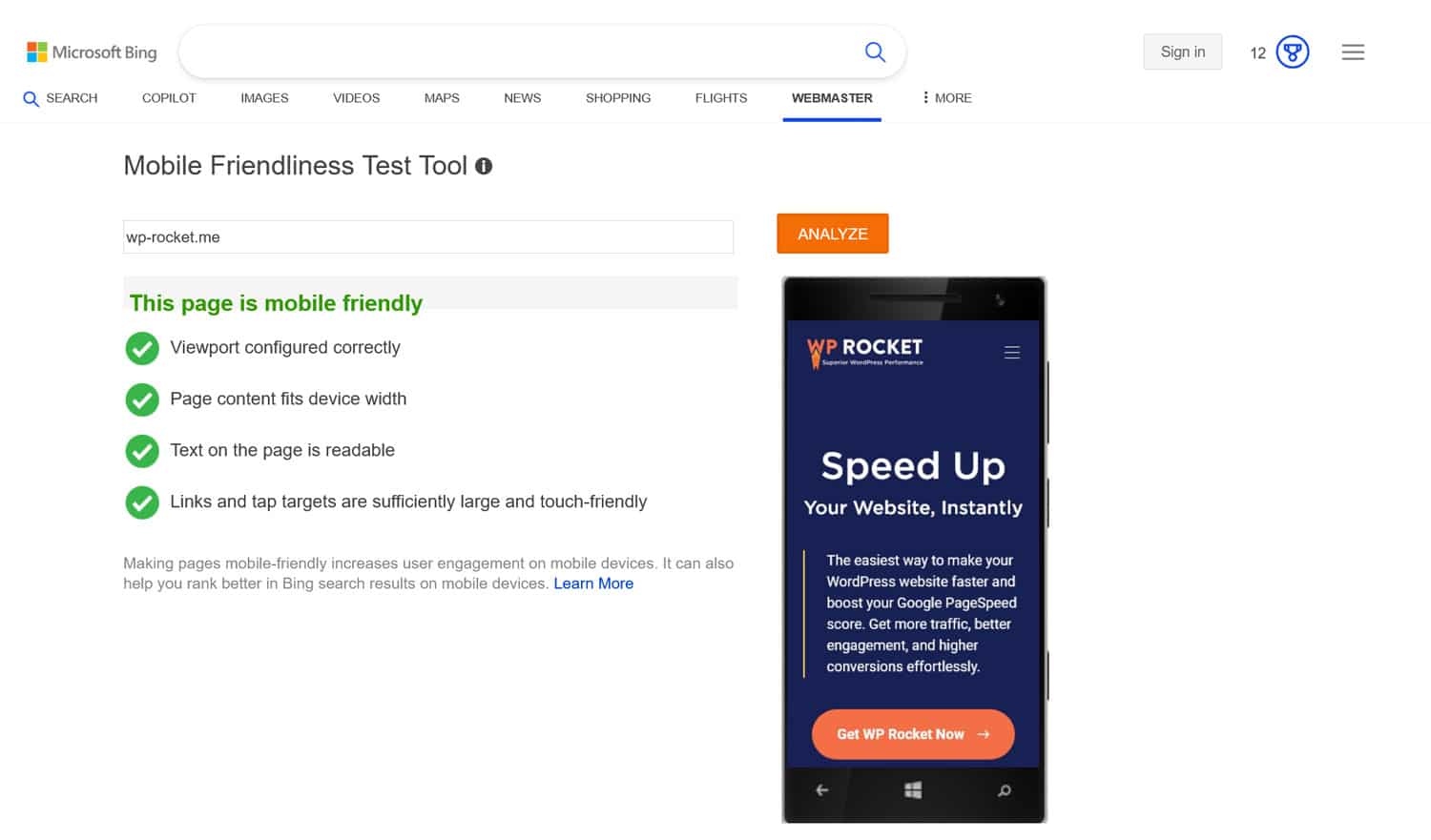
14. Not Optimizing for Voice Search
Another part where mobile users differ from their desktop counterparts is how they search. It should come as no surprise that phones are often used on the go to find specific destinations or local search results like nearby restaurants.
In addition, mobile users are much more likely to use voice-assisted search through virtual assistants like Siri or simply text-to-speech. As a consequence, mobile search queries are often different from those typed into Google with a desktop computer, so don’t make the mistake of ignoring this SEO fact.
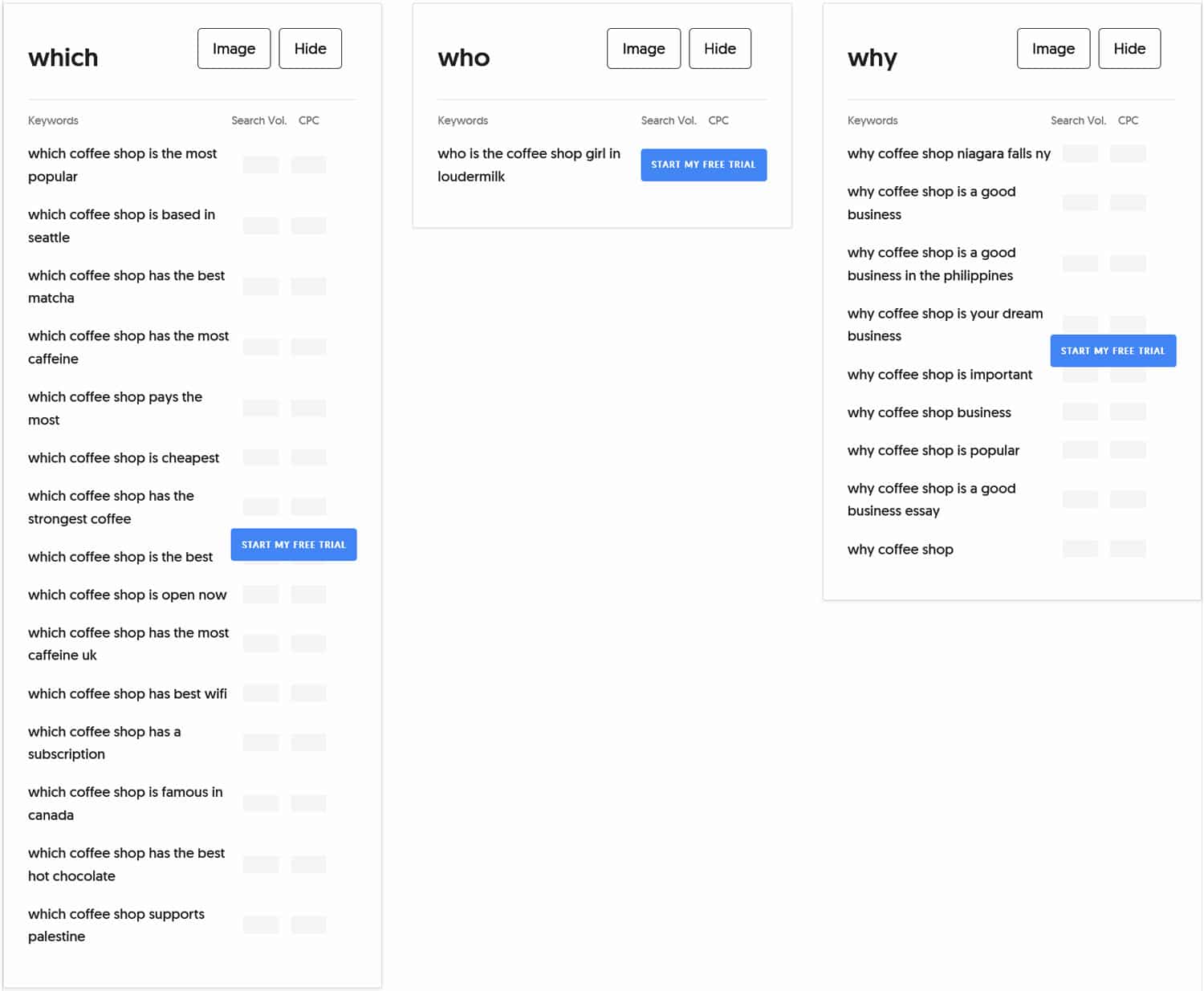
How to Fix Voice Search SEO
The solution here is to include more conversational queries in your content. These can, for example, be questions in your headings or as an FAQ section.
Finding these phrases is part of keyword research. Have a look at your keyword’s search results and the features that show up. They give you a good indication of what people look for in relation to it. You can also use Keyword Tool or AnswerThePublic to collect conversational search queries automatically, such in the screenshot above.
We also have tips for local SEO below.
On-page SEO Errors: Definitely Steer Clear of These
Next up, we are dealing with screw-ups in the on-page SEO department and how to avoid them.
15. Low Content Quality
Search engines try to deliver the best content for their users’ search requests. So, if your content isn’t up to snuff, it won’t show up. In addition, low-quality content is bad for conversion rates, time on site, your reputation, and more.
What SEO mistakes can you make to keep your content quality low?
- Using purely AI-written content
- Lack of editing and proofreading
- Irrelevant, outdated, or factually incorrect content
- Lack of E-E-A-T (Experience, Expertise, Authoritativeness, Trustworthiness)
How to Fix Less-Than-Ideal Content Quality
To fix this issue, start creating content that is:
- Accurate
- Relevant
- Readable
- Useful
- Grammatically correct
- Credible (has strong E-E-A-T)
Basically, the opposite of everything mentioned above. Plus, be conscious of search intent as discussed earlier.
16. Overusing Keywords
Using your main keyword over and over again in your content in the hopes that it will make it rank higher is called “keyword stuffing.”
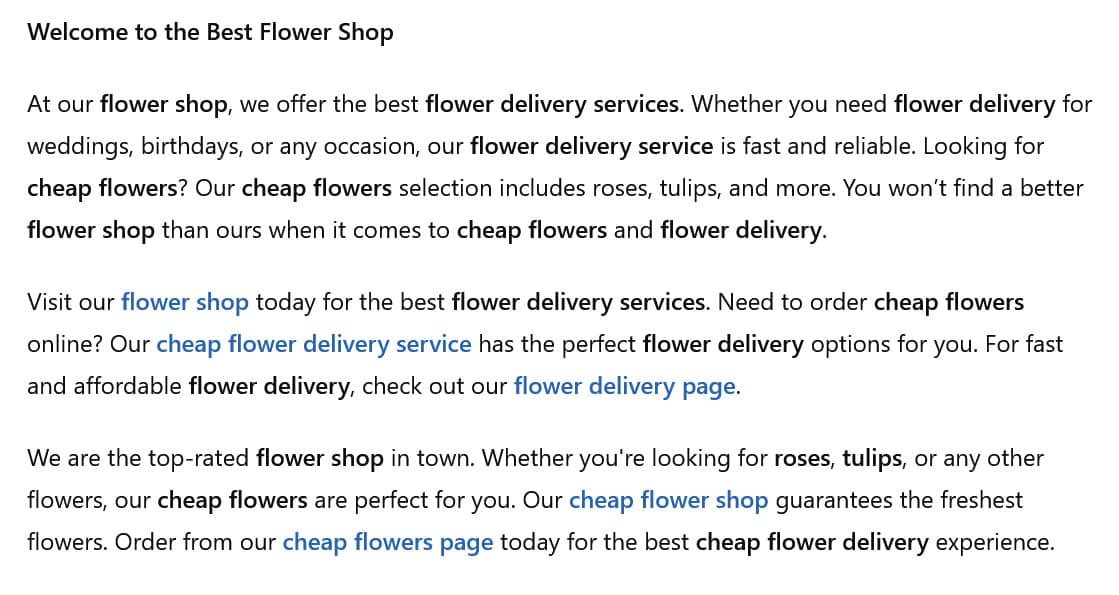
This technique is very outdated and from a time when search algorithms were less sophisticated. These days, it’s a surefire way to search purgatory as it makes your content unpleasant to read.
How to Fix Keyword Stuffing
The solution here is simple: don’t do it. Instead, use keywords naturally.
That means, focus on the topic at hand and create content that’s pleasant to read and covers your subject in depth. If you’ve done your research right, this naturally leads to using the main keyword, related key phrases, and variations.
There are a few places where you should take care to place your main keyword, namely your content’s:
- Title
- Meta description
- Opening paragraph
- ALT tags
- Headings (where it makes sense)
Use an SEO plugin for the above. But aside from that, don’t obsess about it—keywords are less important now than they used to be.
17. Unoptimized Images
Images are important for user experience and accessibility. They can also bring in traffic from Google Image Search, which is one of the search engines in the world in its own right.
In addition, images are an important factor for page performance because they are data-heavy and can literally add several seconds of page loading time.
The most common mistakes people make in terms of optimizing images for SEO include:
- Using images that are too large for where they appear
- Picking the wrong image format
- Not compressing images
There are also image ALT tags, which explain the content of visuals to search engines and people using screen readers.
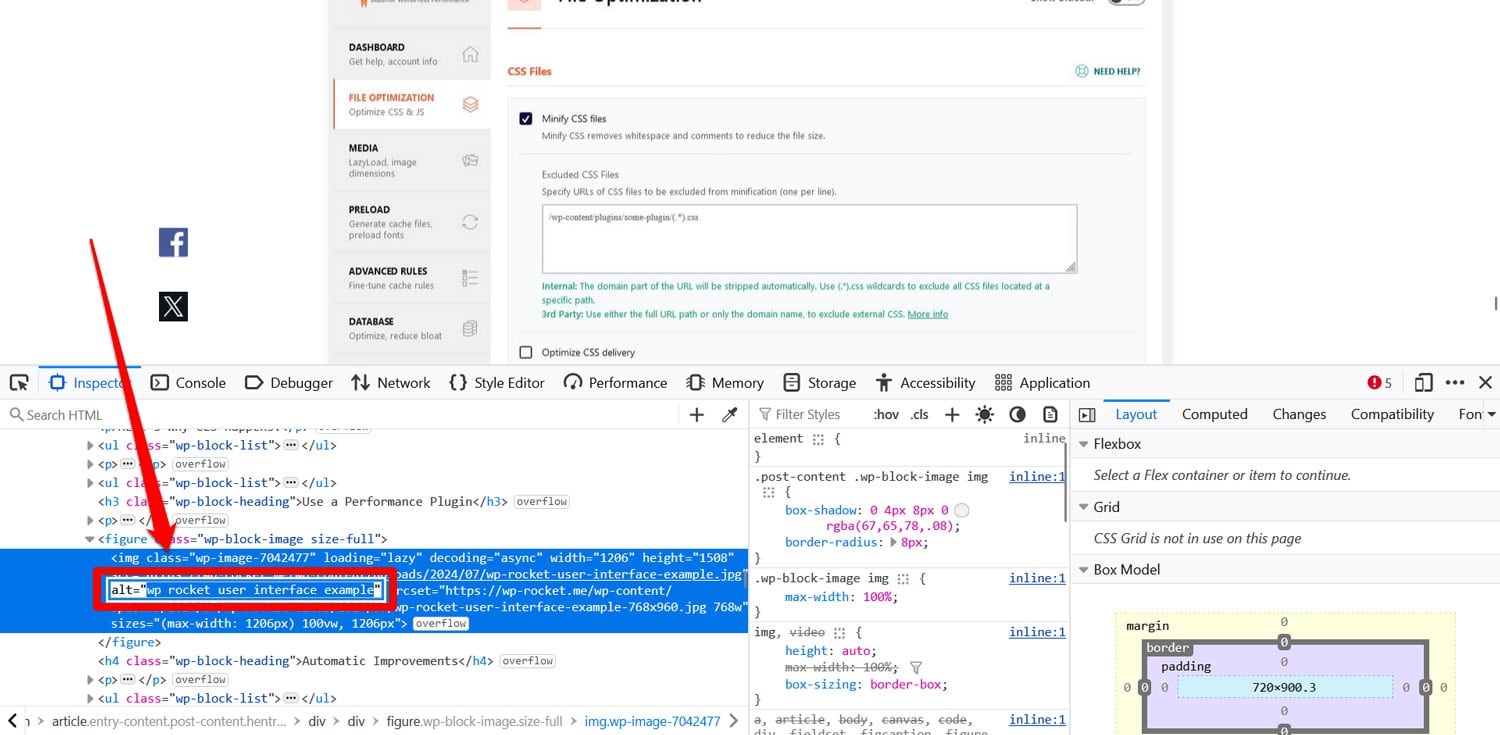
markup
Failing to include these tags or making them too long, too short, keyword-stuffed, or duplicating them are all SEO mistakes to avoid.
How to Fix Image Optimization
Let’s go through each problem above one by one.
First, use images only as large as you need them. Making visitors download a visual that’s 1500 pixels wide but only appears in a 300px space is a waste of data. In WordPress, you can control the image sizes your website automatically creates when uploading under Settings > Media.
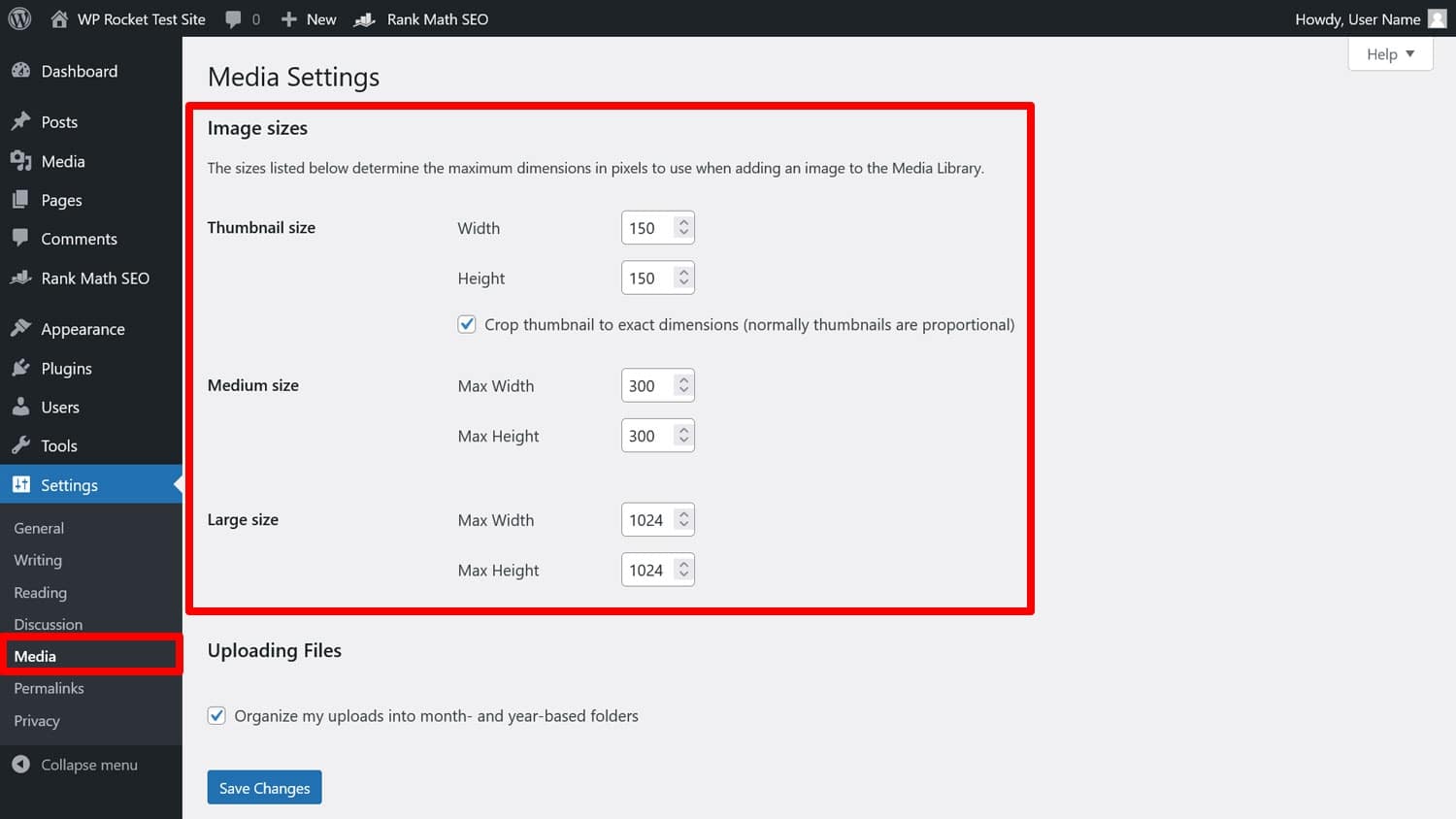
Image formats and compression are usually things you have to fix before uploading. A more convenient way is to use a plugin like Imagify. It can automatically compress and resize images uploaded to your WordPress site without loss of quality, individually and in bulk. At the same time, it has the ability to convert them to modern image formats like WebP and AVIF.
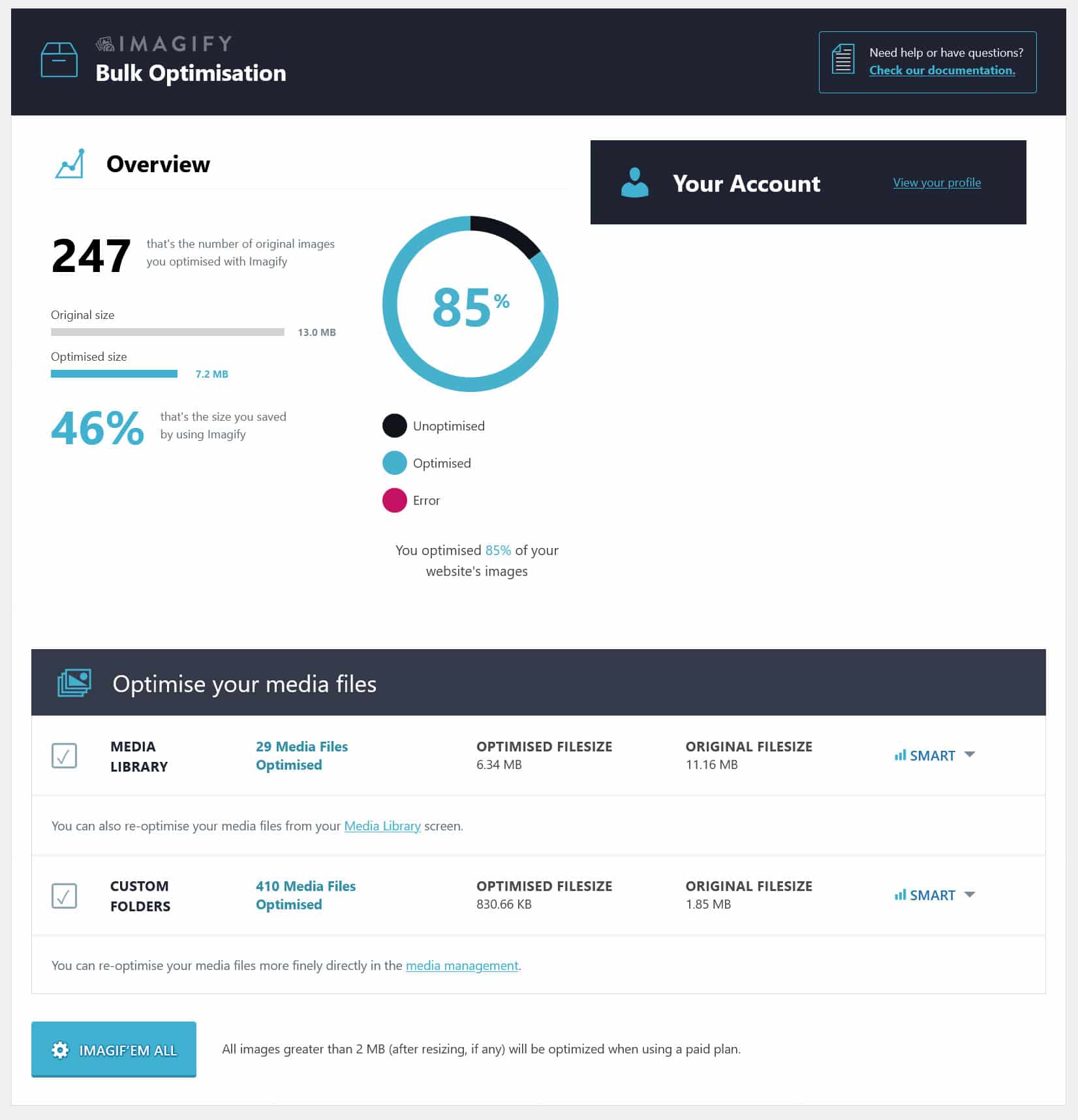
As for image ALT tags, you have two ways to add these in WordPress. One is in your WordPress media library, from where it will automatically be inserted into your pages with the image.
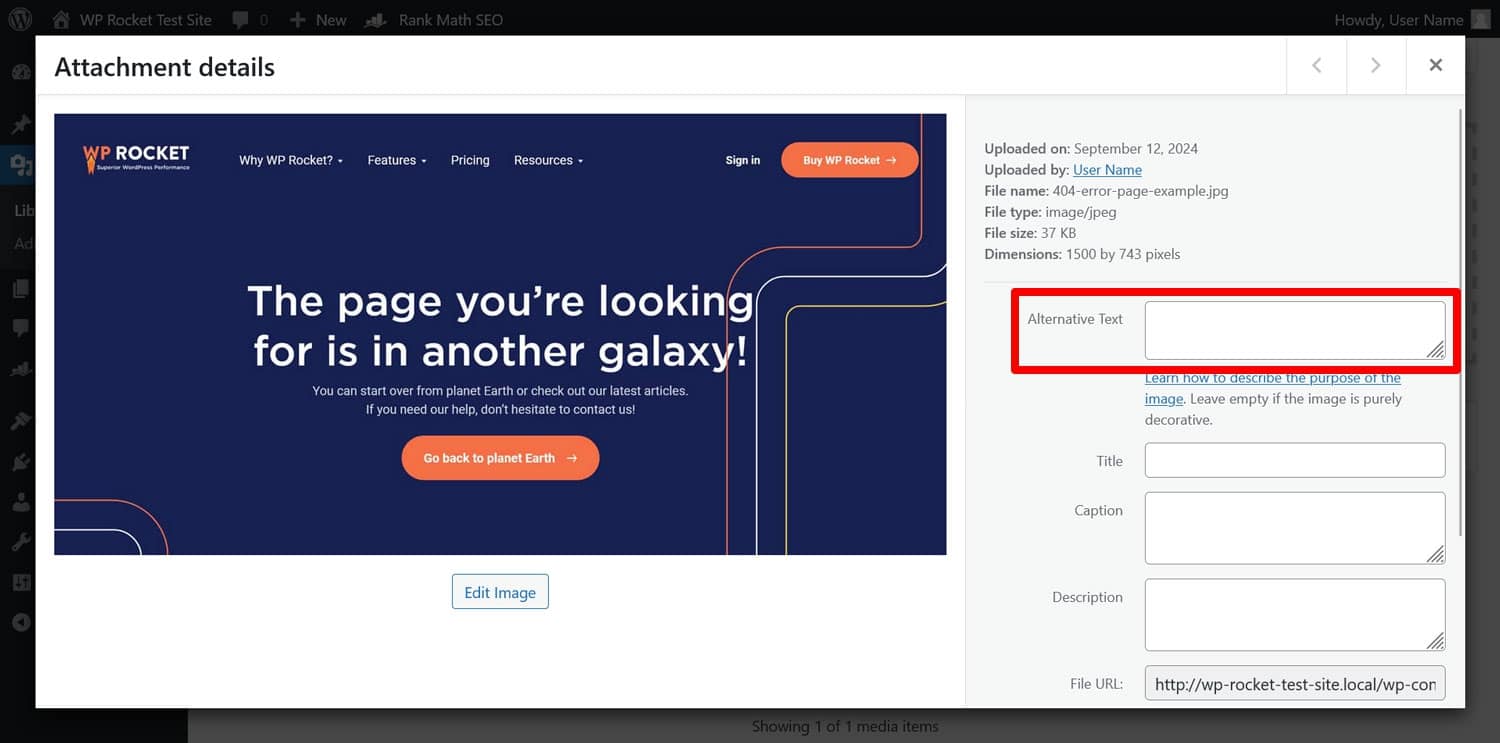
In addition, you can also customize the ALT tags locally for individual posts and pages using the sidebar of the WordPress editor.
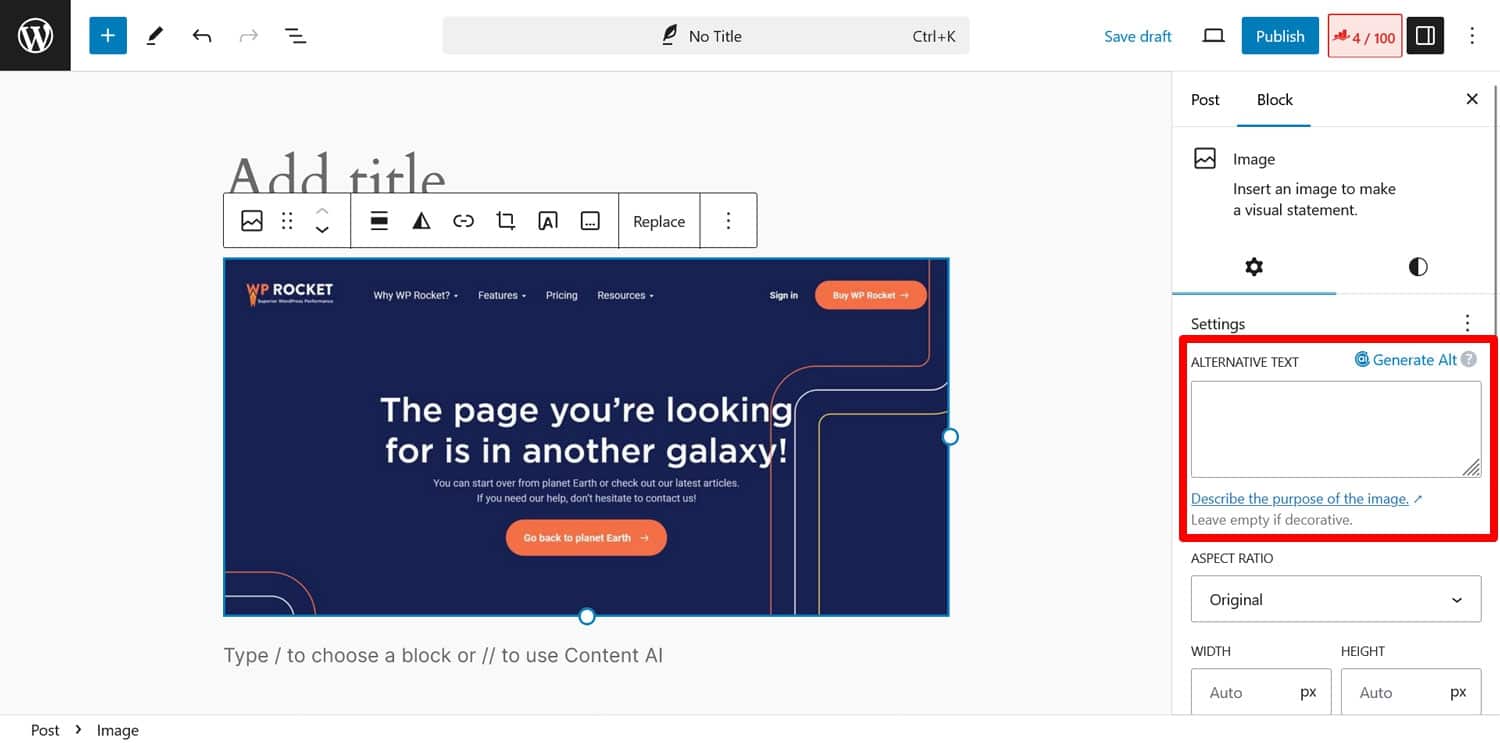
18. Wrong Use of Meta Tags
We’ve already talked about this when discussing the mistake of not using an SEO plugin. Failing to optimize SEO titles and meta descriptions are missed opportunities to improve your standing in the search results. They help you control your content’s appearance and even allow you to include a call to action. Another important meta tag is the ALT tag, which we just discussed.
How to Fix Your Meta Tags
Since we already covered how to add this information to your posts, pages, and images above, here are a few best practices for their use:
- Run tests on your site to find missing title tags and descriptions, e.g. using Screaming Frog
- Include your target keyword in your tags (toward the beginning for the title)
- Make your title and description unique to each page
- Provide an accurate summary of the content you are describing
Internal Linking Mistakes That’ll Lead to a Disconnect
Internal links include your navigation menu, pages, links between blog posts, etc. They help people and search crawlers find their way around your site, understand its purpose, and spread link equity around.
19. Broken Links
Broken links are those that lead to a 404 error page.

They can happen due to mistyped URLs but typically occur because a page no longer exists. Broken links frustrate users and negatively impact SEO.
How to Fix Broken Links
How do you find links without a destination? First of all, they show up in Google Search Console under Pages when you choose to see non-indexed pages and scroll down for the reasons they are not in the index.
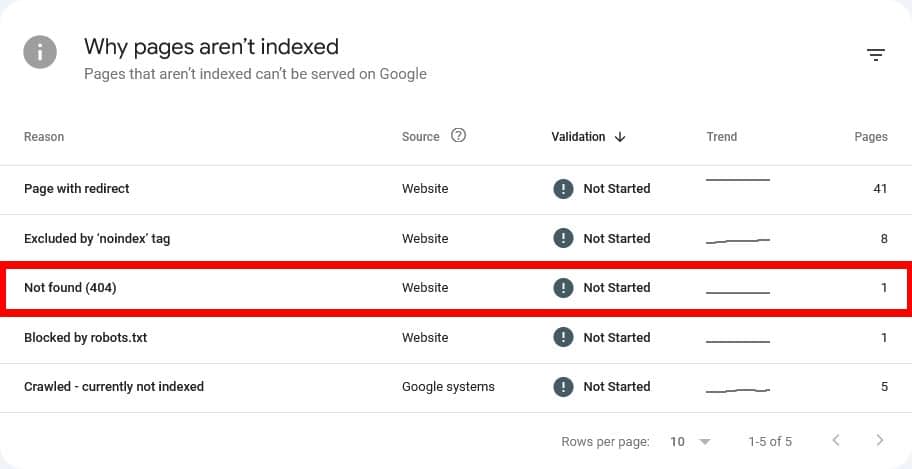
You can also use the aforementioned Screaming Frog or SEO tools like SEMrush and Ahrefs to locate them.
Once identified, fix broken links by setting up 301 redirects to move visitors and search engines to the correct or related content. A plugin like Redirection helps you do so.
Repeat this process regularly for best results.
20. Bad Linking Practices
Besides making sure you don’t have broken links on your site, it’s also important that you properly use the links that do work. Here are some of the link mistakes you can make that hurt your SEO:
- Anchor tag over-optimization – This means using the same exact keyword whenever you link to certain pages or posts on your site.
- Orphan pages – These are pages that receive no links at all on your site, making them very hard to find and index.
How to Fix Link Usage
To avoid these mistakes in the first place, make sure to always link to relevant articles within your content. In addition, use anchor text that accurately describes the link target. Refrain from making it too keyword-rich.
Again, focus on good, natural writing over optimization, otherwise, it will hurt user experience. Read your anchor tags out loud separately and see if visitors would understand where a link points by only hearing it.
These Ecommerce SEO Gaffes Will Wreak Havoc on Your Online Shop
When running an online shop, there are also specific things to keep in mind in order to avoid hurting your search positions.
21. Bad Site Architecture
Site structure is especially important for online shops. More than any other type of site, you want to make it easy for visitors and search engines to find your pages. If the structure is confusing or unpleasant to use, you risk the opposite.
How to Fix E-commerce Site Structure
So, how do you avoid this SEO mistake? Here are a few tips:
- Set up categories and subcategories to order your products and include them in your URLs
- Keep site structure flat—ideally, every page should be reachable with two to three clicks.
- Create a navigation menu that represents your site structure.
- Consider additional navigation elements like breadcrumbs, additional options in the footer, related products, etc.
- Add structured data to your pages (more on that below).
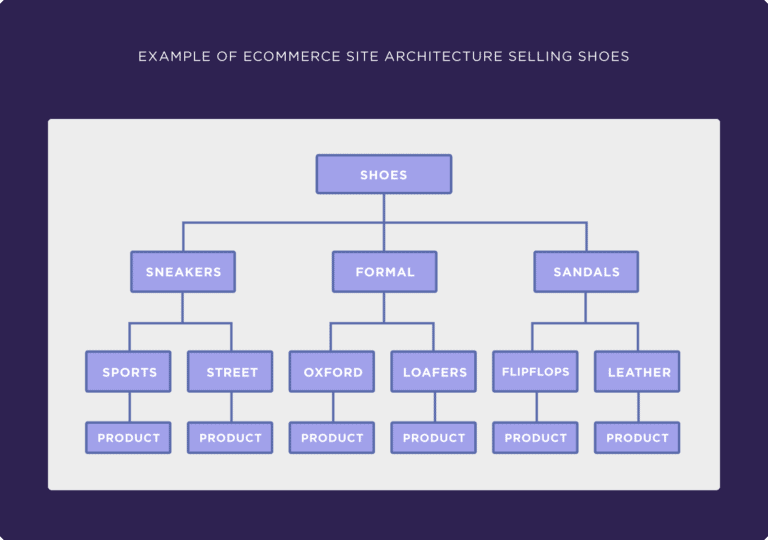
22. Bad Product Descriptions
Descriptions make your product pages unique. Unfortunately, everyone often uses the descriptions provided by the manufacturer, resulting in the same content on everyone’s product pages, including your competitors.
This leads to duplicate content which, as already established, is not a good thing. It also fails to make you stand out from the crowd.
How to Fix Lousy Product Descriptions
The fix for this problem is obvious: Write your own descriptions. Yes, it’s more time-intensive, but it pays dividends in the long run.
23. No Schema Markup
You’ve most likely seen schema markup (also called structured data) in action before. It’s responsible for search results with additional information like images, ratings, reviews, and event details.
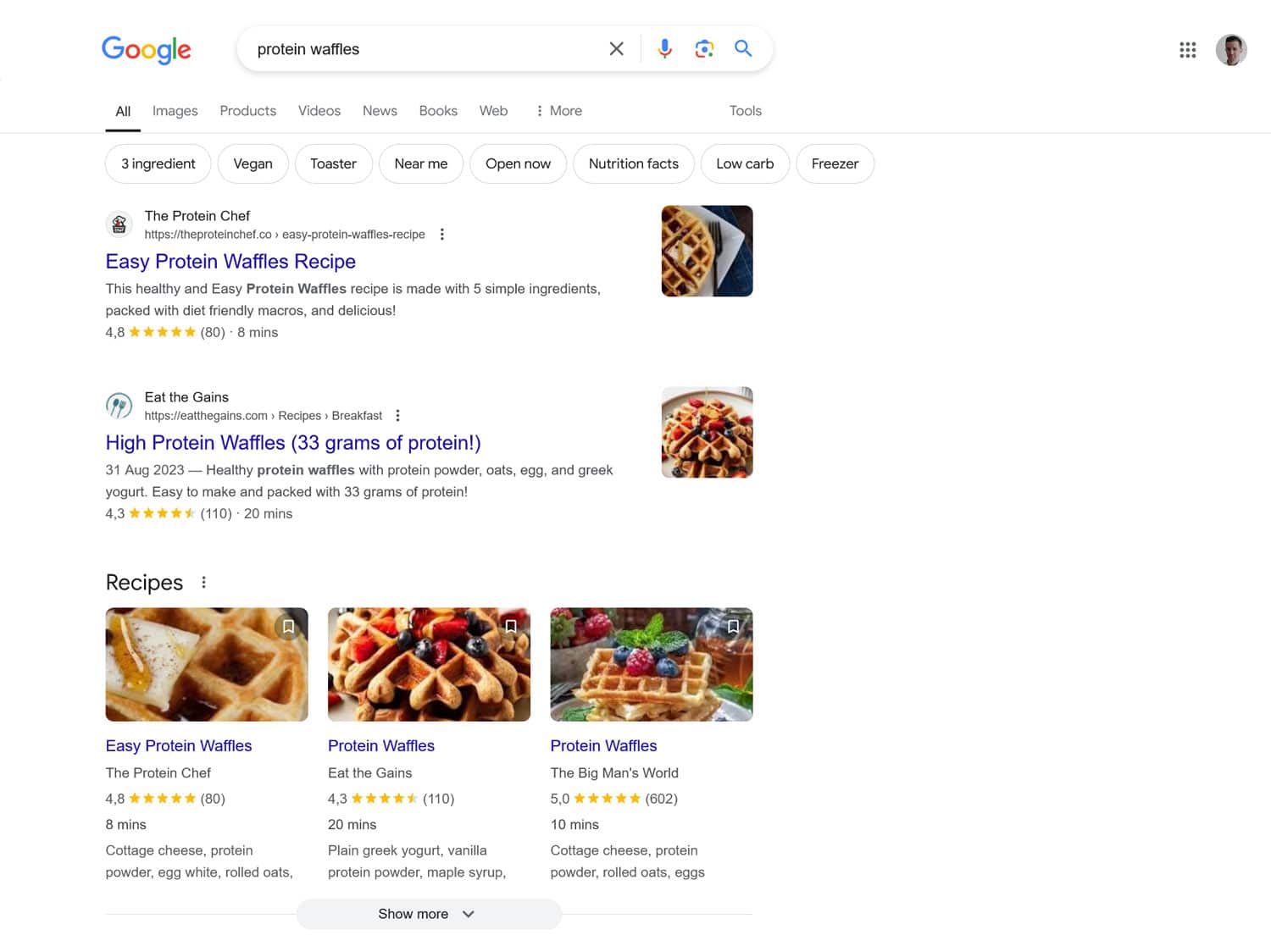
Uzair Nazeer Bhat, Operations Director at Rank Math SEO, suggests:
Schema is what helps Google understand the meaning behind your content—not just the words on the page. If you care about long-term rankings, user intent, and being featured in SERP enhancements, then Schema is an essential part of your SEO toolkit. Not using it is a choice to be invisible in an increasingly competitive space.
Schema markup helps improve click-through rates, which means not using it can be a mistake for your SEO, especially for certain types of content.
How to Fix Missing Structured Data
How can you add schema data to your site? Many popular SEO plugins are able to do it for you, or you can use a standalone solution like Schema. It exists for recipes, reviews, events, FAQs, blog posts, multiple locations for local businesses, and more.
However, don’t overdo it. Avoid adding irrelevant information to your pages, as this violates Google’s guidelines.
International SEO Mistakes That Won’t Take You Global
If your site is operating internationally, there are also a number of SEO mishaps to avoid.
24. Using the Same URL for All Language Versions
You can set up international versions of your website in different ways: Using a separate domain, a subdomain or subdirectory, or by appending your URLs with a parameter.
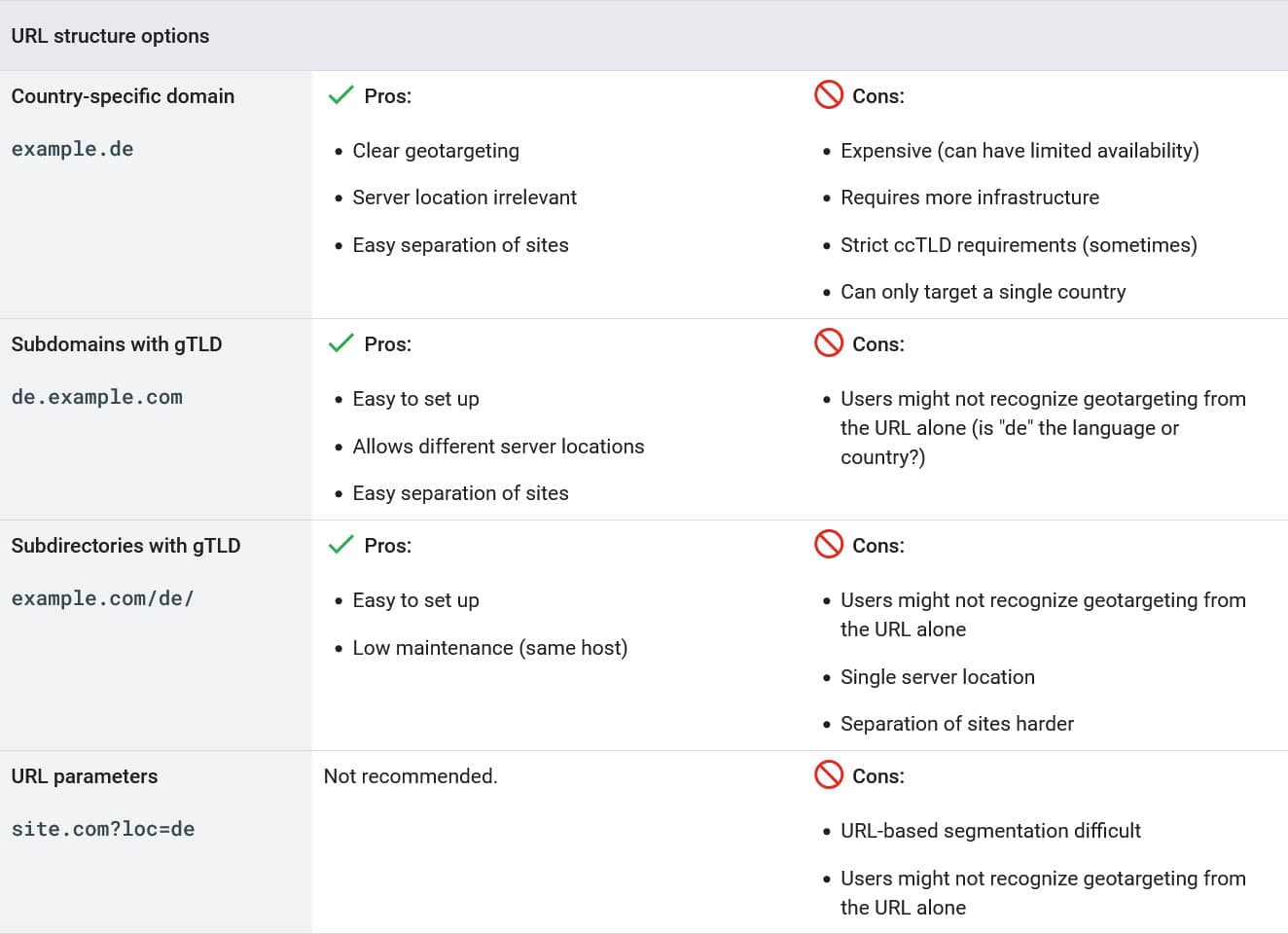
Each of these methods has pros and cons, but all are more or less accepted by Google. One of the only mistakes you can make for your international SEO is to use a single URL and show different content depending on visitor locale or browser language. Doing so makes it hard to index for different locations.
How to Fix International Domain Problems
Simply use one of the other structures laid out above. Together with the correct hreflang tags (see below), this should be enough to have your translated pages appear in the correct search markets.
25. Incorrect Use of Hreflang Tags
Hreflang tags are code snippets that tell search crawlers the language and geographical location a web page is intended for. They look a little something like this:
<link rel=”alternate” href=”https://yoursite.com/de” hreflang=”de-de” />
This matters for international websites that might have pages with virtually the same content but aimed at different language markets. They allow you to signal to search engines that you have separate localized page versions for individual locations, even if the language is the same. That way, you are able to rank in the correct search markets and avoid penalties for duplicate content.
Of course, if you make the mistake of using hreflang tags incorrectly, you can also mess up your SEO.
How to Fix Hreflang Tags
Hreflang tags are a tricky beast, so it’s best to inform yourself properly on how to use them before including them on your site. We don’t have enough space here to do so, but this is a great article on hreflang tags.
If you need help setting up hreflang tags correctly, consider using a translation plugin.
Local SEO Missteps Your Customers Won’t Appreciate
Now we are getting to the mistakes you can make when trying to optimize for local search traffic.
26. Failing to Optimize Your Google My Business Profile
Over time, Google has added new features to its search results. One that’s particularly important for SEO is the so-called “local three-pack.” It often appears for local search queries and shows three businesses that fit it.
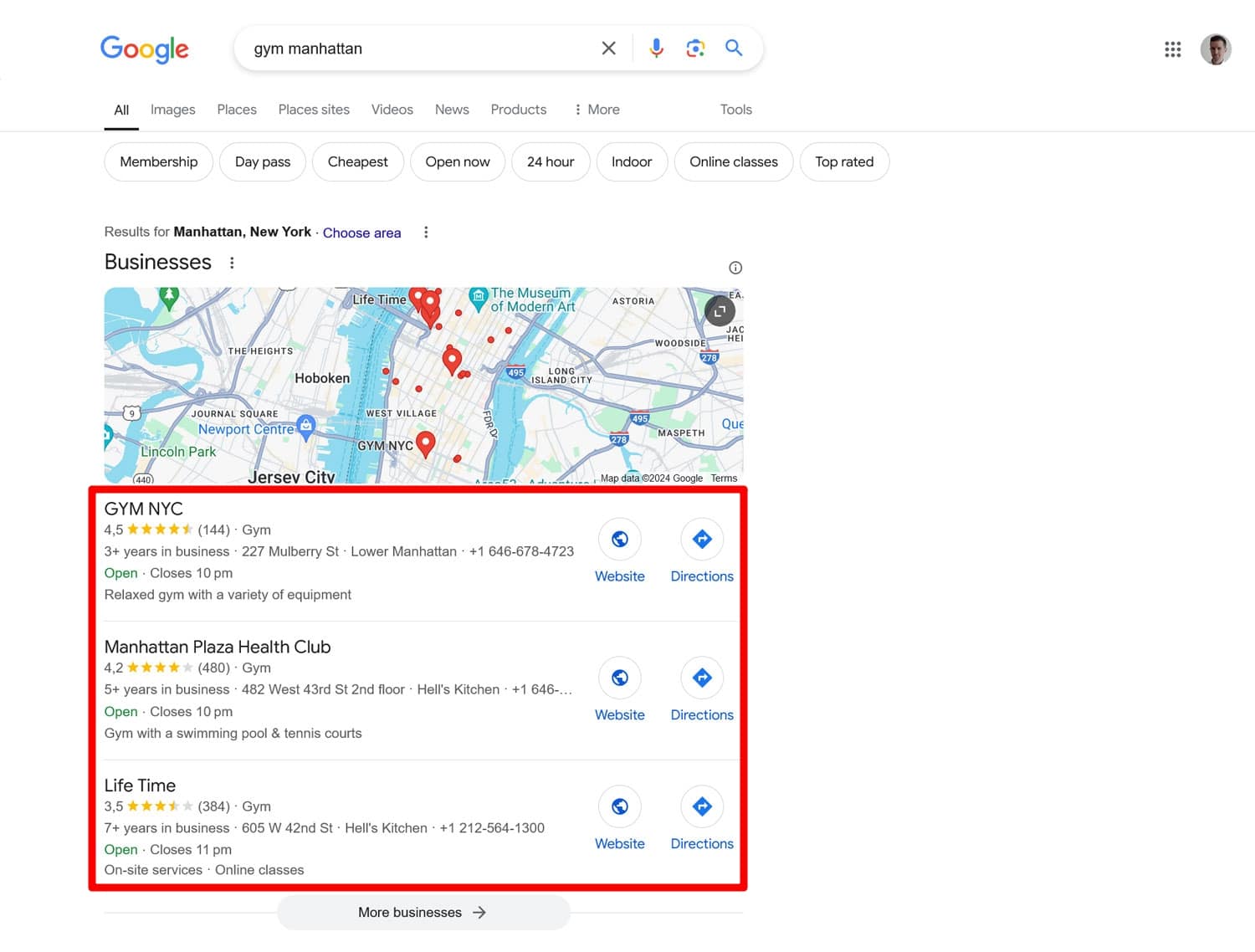
These businesses appear very prominently, with good visibility. However, only businesses that have a Google profile appear here. Therefore, a local SEO mistake you can make is quite obvious—not setting up a profile for your business.
How to Fix Your Google Profile
The solution to this problem is also easy to guess: set up a Google profile for your business.
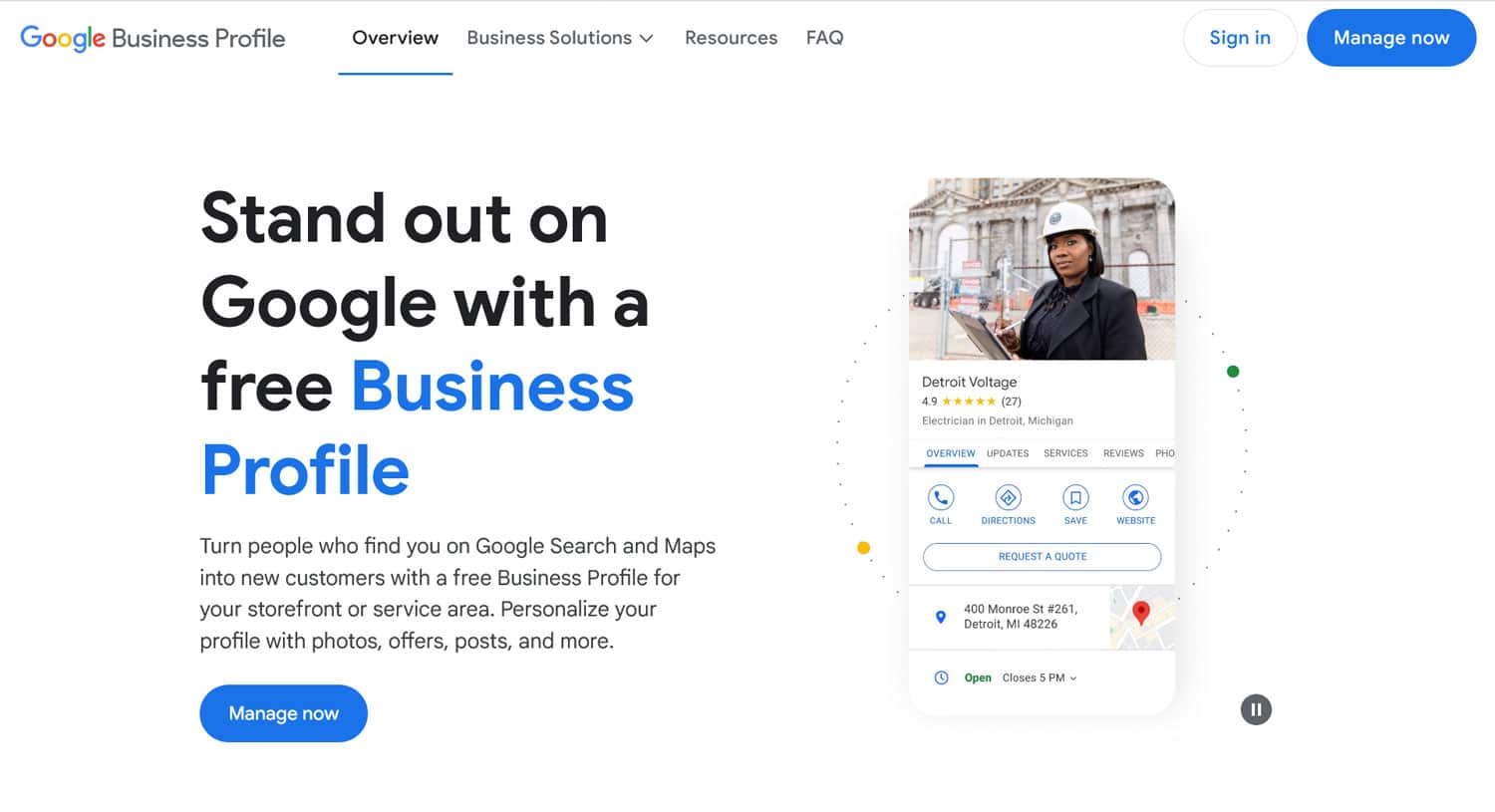
To make it most effective, take advantage of all the possibilities it offers. Fill out all the information available, including address, contact information, hours of operation, etc. Doing so increases your chances of showing up for relevant searches.
27. Having No Strategy for Reviews
Reviews are critical for building trust and credibility for your business. 95 percent of online shoppers rely on online reviews to make purchase decisions. Therefore, one of the worst e-commerce SEO mistakes you can make is failing to implement a workflow for online reviews or completely ignoring them.
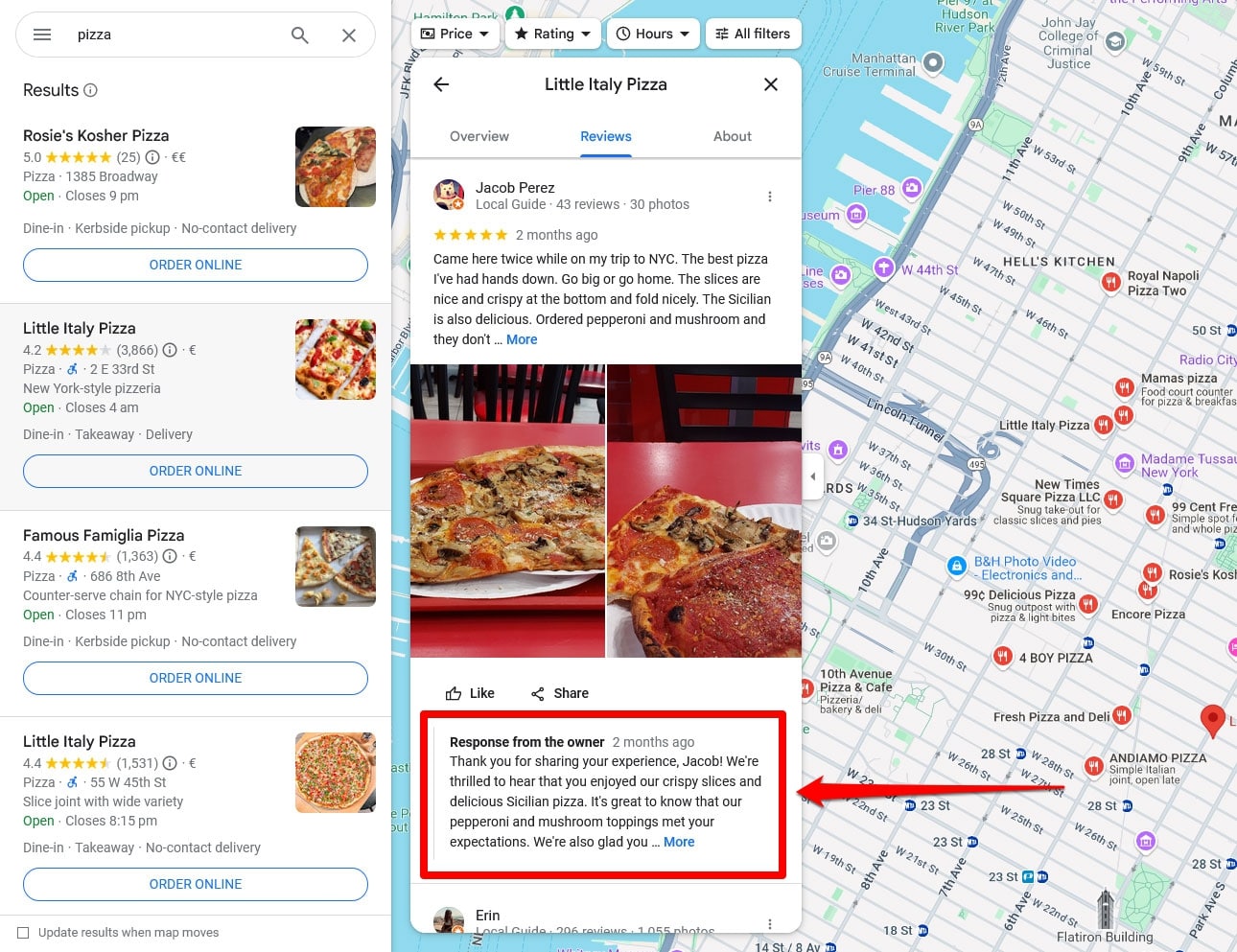
That’s a surefire way to gamble with your reputation and leave potential customers with a bad impression.
How to Fix Online Reviews
When dealt with properly, customer reviews can actually be a boon for your business. They deliver valuable feedback and are a great opportunity to interact with your clientele, clear up misunderstandings, and present your brand and business. Follow these guidelines to do so:
- Identify your platforms – Which review sites are most important in your industry? Be sure to be present on the most important ones.
- Encourage reviews – Let customers know you value their feedback and tell them where they can review your products and company.
- Respond to all reviews – Whether positive, negative, or neutral, have a process in place to answer reviews across all relevant platforms, in a timely manner, and in a personal, professional, and polite way.
28. Not Using Local Keywords on Your Website
Google My Business is not the only way to show up in local search results—your own website is also an access point you should not neglect. However, if you don’t provide any help to search engines about the context you want to appear in, they are unable to show you there. Therefore, the final SEO mistake you can make on a local level is neglecting to include local keywords on your website.
How to Fix Local Keyword Usage
The fix for this problem is to include keywords that better classify your website for local search. These usually mention the location of your business, important landmarks nearby, business hours, and similar information a person on the go would look for.
For example, instead of simply using the homepage title “Joey’s Pies – Pizza Restaurant,” you would go with something like “Joey’s Pies: The Best New York-Style Pizza Near Yankee Stadium.” That way, you have a much higher chance of ranking for relevant search inquiries.
Other SEO Mistakes You Shouldn’t Make
Finally, let’s cover some mishaps to avoid that didn’t fit into any of the categories above.
29. Disregarding User Experience (UX)
It has always been the goal of search engines to provide the best results for their users. The main objective here is that they direct users to pages that are relevant to their search. But at the same time, search engines want users to have a good experience—something that Google increasingly measures directly.
We have already talked about this above. So, if at this point you are still treating SEO mainly as a technical checklist instead of a holistic page experience, you’re making a grave mistake.
How to Fix Website User Experience
For a good user experience, you need to basically pay attention to the tips mentioned above concerning:
- Site speed, especially Core Web Vitals
- Search intent
- Content quality
- Mobile-friendliness
- Use of HTTPS
- Internal linking
- Image optimization
If you implement all of the above, you are well on your way to providing a stellar user experience on your website, improving your SEO in the process.
30. Not Treating SEO as an Ongoing Process
SEO is not a one-time thing that you do once and forget about. Search algorithms are always evolving, as are SERP features. Along with them change the demands on websites and how they operate.
Plus, your business is likely not going to be the same forever. Finally, your competitors don’t sleep either—they’re always working to improve their websites in order to pass you and others by in search results.
How to Fix Your SEO Attitude
See SEO for what it is: continuous work. Here are a few things you should do on a regular basis:
- Keyword research
- Content creation on relevant topics
- Building and earning backlinks
- Keeping your site technically sound (especially performance)
- Updating existing content
Steer Clear of These SEO Mistakes for a Better WordPress Website
Avoiding common SEO blunders is crucial to improving your website’s visibility, traffic, and overall success. From technical issues like crawlability and site speed to WordPress-specific problems such as improper URL structures, each mistake can significantly impact your rankings. Fortunately, most of these errors are easy to spot and fix with the right tools and knowledge.
By regularly auditing your site, optimizing for mobile and local search, and focusing on quality content, you can stay competitive in search engine rankings. Just remember, SEO is an ongoing process, not a one-time effort. Stay proactive, keep your website in good shape, and continually adapt to SEO best practices to ensure long-term success.



